Paul Bishop's Blog, page 21
October 3, 2017
STARK REALITIES


STARK REALITIESSTARK HOUSE PRESSPUBLISHERGREG SHEPARD
Stark House Press is renowned for breathing new life into great books by great writers—writers who have slipped out of the mainstream into the murky depths of the noir and hardboiled underworld. United by their mesmerizing plotting, scorching prose, and flawed characters, every reprint from Stark House is beautifully packaged with incisive and informed introductions from some of the most knowledgeable noirmeisters and hardboiled mavens in the genre.
 Books by writing giants such as Harry Whittington, Frank Kane, Carter Brown, Cleve Adams, Peter Rabe, Fletcher Flora, Malcolm Braly, W. R. Burnett, Arnold Hano, Dan J. Marlowe, and too many others to name, have been brought back from the edge of obscurity by the guiding hand of Stark House Press’ unassuming editor, Greg Shepard.
Books by writing giants such as Harry Whittington, Frank Kane, Carter Brown, Cleve Adams, Peter Rabe, Fletcher Flora, Malcolm Braly, W. R. Burnett, Arnold Hano, Dan J. Marlowe, and too many others to name, have been brought back from the edge of obscurity by the guiding hand of Stark House Press’ unassuming editor, Greg Shepard. Operating in the shadows, Greg has been quietly feeding the desperate needs of mainlining noir, hardboiled, and even Western junkies for far too long without due recognition. Having been a regular reader of Stark House Press’ fantastic output, I’m delighted Greg agreed to be interviewed and share his thoughts about the books and authors Stark House continues to feature.
Operating in the shadows, Greg has been quietly feeding the desperate needs of mainlining noir, hardboiled, and even Western junkies for far too long without due recognition. Having been a regular reader of Stark House Press’ fantastic output, I’m delighted Greg agreed to be interviewed and share his thoughts about the books and authors Stark House continues to feature.********If a scheming femme fatale falsely accused you of murder and you were on the run, what information would the police’s APB contain?
Born in 1952 in Ft. Collins, Colorado. Grew up in Northern California. Spent childhood in the Sacramento area, Marin County and Pacifica. At various times, I’ve been a painter, graphic designer, rock music critic, clerk, book buyer, publisher’s sales rep, book distributor, tenant relations coordinator. Currently, publisher of Stark House Press in Eureka, California. I married Cindy Brown in 2013, have two sons—Justin and Cole— by previous marriages, and a house full of books, movies, music, animals and art.
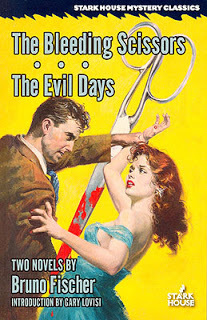 What are your first memories of reading?
What are your first memories of reading?I was a sucker for Dr. Seuss when I was a kid—still am. Once a week, my mom would take us to the library so we could stock up. From Seuss, I graduated to animal stories in grade school, and then to science fiction, horror, and mysteries. In my very early teens, my grandmother (bless her) gave me a pile of Edgar Rice Burroughs books—the old Ace editions—and I was off and running into adventure-fantasy land. You might say I trace my reading arc from Cubby in Wonderland to Mysterious Island to Pellucidar to The Big Sleep. Something like that.
When did you first begin to read widely in the noir and hardboiled fields?
I read a lot of Phyllis A. Whitney’s young adult mysteries when I was entering my teens, but didn’t start reading Chandler, Hammett, or Cain until I was in my late teens and early 20s. Mostly, I read a lot of science fiction. Then in the mid-1980s, I discovered Maxim Jakubowski’s UK Black Box Thrillers, and read them all from beginning to end. From there, it was a just a matter of time before I started tracking down every single Gold Medal book I could find. Around this time Black Lizard started up, and I was able to read the Jim Thompson books I hadn’t been able to find. It was a good time to discover noir.
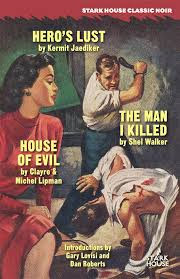 Can you tell us a little about the history of Stark House Press?
Can you tell us a little about the history of Stark House Press?The publishing company came from a suggestion made by my dad, Bill Shepard. He had been a newspaper writer and magazine editor most of his life. He thought it would be interesting to start a publishing company. My brother Mark is a graphic design artist, my mom, Joanne, a proofreader, and my ex-wife handled the cover art. I was in charge of acquisitions. I started with Storm Constantine, but quickly moved to mysteries when the rest of the family dropped out.
Why did you decided to start Stark House Press?
I had always wanted to be a publisher myself, even as far back as high school. My fantasy then was to reprint everything by all my favorite authors. Which is sort of what I’m doing today. I can’t speak for my dad, who is no longer with us, but I imagine he wanted to start a new business just to see if we could succeed with it. He had quite the entrepreneurial spirit, no doubt about it. For me, it’s an outgrowth of being a book collector, and wanting to spread the gospel, one reprint at a time.
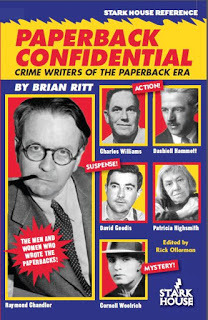 Is there a story behind the Stark House name?
Is there a story behind the Stark House name?I originally suggested Dark House, but when I looked into it, there were just too many publishers at the time with the word dark in their name. I thought stark sounded cool without being specific to any one genre, and suggested it to the group. It stuck. Many California book buyers knew me from the time when I was a sales rep for a fellow named J. Ben Stark, who imported British paperbacks. They thought I had named the business after him. But it was one of those weird coincidences. The family liked Stark House, and it became the name we settled on.
What do you look for when deciding on a new Stark House Press title?
I started by tracking down the rights to all my favorite authors, like Elisabeth Sanxay Holding, Peter Rabe, Gil Brewer, W. R. Burnett and Harry Whittington. At this point, I keep myself open to new authors who submit something I get caught up in myself; or classics on my fantasy wish list; or authors who are offered to me, like Carter Brown.
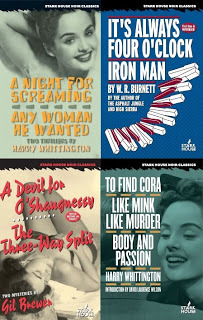 Are there any authors who you would like to publish, but for haven’t been able to pin down?
Are there any authors who you would like to publish, but for haven’t been able to pin down?I’d love to reprint David Goodis’ Somebody’s Done For. The lawyers who control the estate shot down my offer. I tried to work a deal to reprint Build My Gallows High by Geoffrey Homes, but the family wanted more than I could spend. There are some books for which I haven’t been able to track down the estate, such as A. H. Z. Carr’s Finding Maubee, and other authors, like Davis Karp, I simply haven’t succeeded in tracking down yet. Ed Gorman tried to put me together with the Robert Bloch estate, but they never got back to us. It was a pet project of Ed’s, and I’m sorry we couldn’t make it happen before he passed away.
Do you have any personal favorites among your Stark House Press titles?
The Box by Peter Rabe prompted me to read the rest of his books, so it was the first book of his I reprinted. I love that book! Such a treasure. Same with Pure Sweet Hell by Douglas Sanderson, and Something in the Shadows by Vin Packer. I love A. S. Fleischman’s Far East thrillers, and almost anything by Holding and Brewer—even the weird late-period books.
Any particular acquisition coups among the books you’ve published?
Considering the netherworld of small press publishing—and the even more confining world of retro noir reprinting—my coups have been small, personal ones. Like finding Peter Rabe’s agent via Ed Gorman; or tracking down Elisabeth Sanxay Holding’s grandson, who controls her estate. Probably the trickiest two estates to locate, though, turned out to be James McKimmey’s and Lionel White’s. A lot of online investigative work went into those two.
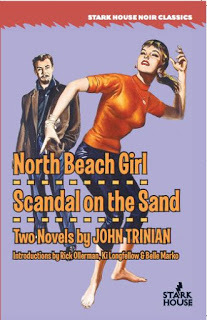 How do you match the writer of an introduction to a particular book?
How do you match the writer of an introduction to a particular book?For awhile, it seemed like Rick Ollerman and David Wilson were writing most of our introductions. They have their favorites, and I would always go to them first when the author was someone like Peter Rabe, W. R. Burnett, Harry Whittington or Charles Williams. But lately, I have been searching out new voices, or authors I know to be fans. For example, Bill Crider was generous enough to provide the intro for the upcoming Richard Wormser book. The suggestion to approach Bill actually came from the owner of the literary agency that controls the Wormser estate. He knew Bill was a fan. When I was trying to find someone to introduce our recent Basil Heatter book, I was up against it. No one I knew had read him. Finally, Steve Lewis, the man behind Mystery*File, was kind enough to provide some thoughts after I sent him the books to read. There really isn’t a formula for matching introduction to book. Sometimes it’s a case of finding out a modern author is a fan of someone we’re reprinting, then asking them if they’d like to contribute.
Why do you feel it is important to keep these writers and their books available?
Good question. I could come up with all sorts of intellectualized reasons, but the fact is, I think books by these authors are as readable today as they were when they were written. The trappings of a story may have changed—in the 50s, everyone, it seemed, drank a lot, smoked a lot, and only paid two bits for a decent diner meal—but the essential conflicts remain the same. Particularly as regards characters who chase after money and sex and come to a bad end. That story is timeless. And when you think of authors like Rabe or Brewer, you ask yourself, why shouldn’t they still be in print? They’re so damn good.
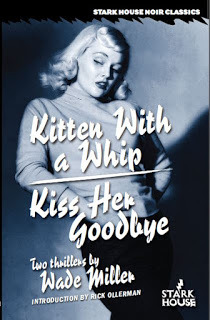 How have advances in the technical side of publishing been advantageous to Stark House Press?
How have advances in the technical side of publishing been advantageous to Stark House Press?Personal computers made desktop publishing possible in the first place. The Internet made it possible to connect easily with the rest of the world. Print on demand certainly made it a whole lot cheaper to keep books in print, to reprint them cheaply and quickly. Honestly, if I had wanted to get into the publishing industry even 30 years ago, I probably would have had to move to New York. Now, I get to live on the California coast in the redwoods, and publish books as well. Practically any technical advance you can think of in the world of publishing has been advantageous to Stark House.
How has Stark House adjusted to the ebook market and is there an average split between the ebook sales and the sales of a trade paperback for individual titles?
I’m retro enough I still prefer printed books, so was very late to get into the ebook game. And I still don’t have all our books available in electronic format. Most of our books sell more than twice as much in paperback as a result. There are occasional titles like Red Hot Typewriter, our John D. MacDonald bio, which sells a lot better in ebook, and some of the new authors we’ve published have also done very well in the medium. Getting more ebooks out is a work in progress for me.
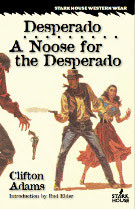 How important is your website and mailing list to the success of Stark House Press?
How important is your website and mailing list to the success of Stark House Press?I get very little feedback on the website. We don’t get a lot of orders directly from it. However, I like to think the hits we get are from customers who then look for the book elsewhere. The folks on the mailing list get a physical catalog, but it’s not the best way of scaring up business—not anymore. I’m just a holdover to the good-old-days when publishers put out paper catalogs to promote their books. I still have a stack of old Ace Books catalogs I kept from the 60s and 70s, more for the sake of nostalgia than anything else. But lately, since making all our books available through Ingram [*a book distribution service], we have started to reach more bookstores, which has made a far bigger difference than the website. Also the Stark House Crime Club, which guarantees its members will receive each new book we publish. That’s worked very well.
How important are Amazon reviews for Stark House Press titles?
I tend to think they’re very important. I know I buy stuff based on Amazon reviews. I’ve even started quoting Amazon and GoodReads reviews on the back of our books. There are a lot of intelligent and articulate readers out there writing some very discerning comments on the books they read and the music they listen to. I don’t have any numbers to justify my view that Amazon reviews sell books, but I figure if it works for me, it probably works for a lot of other readers. And, for better or worse, Amazon still accounts for a big chunk of our sales.
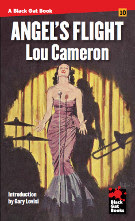
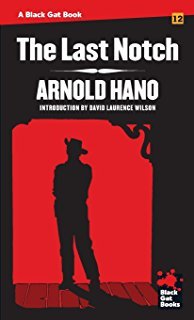 Black Gat Books is a relatively new imprint for Stark House Press. What makes a book qualify for the Black Gat imprint as opposed to a traditional Stark House publication?
Black Gat Books is a relatively new imprint for Stark House Press. What makes a book qualify for the Black Gat imprint as opposed to a traditional Stark House publication?Sometimes you have a single book by an author you love and want to reprint. Or you want to try out an author to see if there is any interest. Or you want to single out a book on its own because it deserves it. I happen to love the 4.25” x 7” mass market book size. I’m also a big fan of standalone novels—not much of a series reader—so I like to find books that stand on their own. I’m reminded again of the Black Lizard books. Cool little books that speak for themselves. There should be more of them on the market today. Black Gat fills that need.
 What can we look for in the next few months from Stark House Press and Black Gat Books?
What can we look for in the next few months from Stark House Press and Black Gat Books?Some authors new to the list like Floyd Mahannah, Richard Wormser and Bill S. Ballinger. Some old favorites like Holding, Rabe and Brewer. Rick and I are working on a Stark House Anthology, which may see the light of day next year. We’ve got another collection of classic supernatural stories edited by Jonathan E. Lewis called Strange Island Stories coming in the Spring. Another Carter Brown 3-fer, the next three Al Wheeler novels. A new mystery by Michael Scott Cain called Damon Runyon’s Boys. Another new thriller from Rick Ollerman, which has yet to be titled. Lots of stuff.
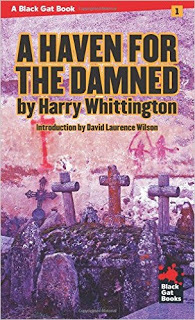 What are your future goals for Stark House Press and Black Gat books?
What are your future goals for Stark House Press and Black Gat books?Personally, I would love to add classic science fiction reprints to Stark House, and diversify a bit more. We’ve started adding some noir westerns to the list. I’d like to add more adventure, fantasy and turn-of-the-century material as well. There’s only one of me, so it remains to be seen what I can accomplish. The noir and hardboiled books are the main focus, though, and will remain so for the time being. There’s still plenty of great material crying out for reprint.
*******Thx to Greg Shepard for taking time to answer so many questions. CLICK HERE to check out the latest Stark House Press publications, and both upcoming and backlist titles...
Published on October 03, 2017 23:03
September 30, 2017
GAME, SET, MATCH
 GAME, SET, MATCH
GAME, SET, MATCHThe Battle of the Sexes is a well written, well-acted, well directed film with few surprises and, consequently, less impact than it should. The 1973 tennis match between Billie Jean King and Bobby Riggs is well documented—not only as a touchstone moment in sports history, but in the evolution of Western society. Specifically, it became the face of the burgeoning sexual revolution, and a rebel yell in the fight for women’s equality. It was also a defining moment in the lives of two disparate, flawed, very human individuals played out in the glare of the media spotlight.
 While Emma Stone and Steve Carell inhabit their characters, the film plays so safe with the events, it is impossible to get lost in the portrayals. We never forget we are watching two actors doing a fantastic impression of two historic figures moving relentlessly toward an intersecting destiny. The problem can be traced to directors Valerie Faris’ and Jonathan Dayton’s choice to limit the film by turning two-thirds of the narrative into a personal story in which King anguishes over her bisexuality.
While Emma Stone and Steve Carell inhabit their characters, the film plays so safe with the events, it is impossible to get lost in the portrayals. We never forget we are watching two actors doing a fantastic impression of two historic figures moving relentlessly toward an intersecting destiny. The problem can be traced to directors Valerie Faris’ and Jonathan Dayton’s choice to limit the film by turning two-thirds of the narrative into a personal story in which King anguishes over her bisexuality.In the late ‘70s and early ‘80s this might have been a revolutionary story deserving of being made the focus. However, as awareness of the LGTB community has made strides in the intervening years, the more interesting story relevant to today becomes Billy Jean King’s singular focus and dedication to her sport. Her sexual orientation is part of her story, but to make it the only part is to belittle Billy Jean King’s major accomplishment—the exposure and beginning deconstruction of a male dominated society.
In real life, the actual tennis match between King and Riggs transcended the individuals involved. So too, The Battle of the Sexes, is finally allowed to roar with the first serve of the fantastically recreated tennis match. Despite knowing the historic outcome, everything that had gone before—King’s lifestyle choices, Riggs’ gambling addiction (which gets short shrift, being played more for laughs than pain)—fades away as the pock, pock, pocksound unique to tennis rivets and grabs your whole attention. Finally, the film eclipses its faults and double-faults and begins to soar.
Published on September 30, 2017 12:33
September 28, 2017
TAMIL PULP—SARIS AND DAGGERS!
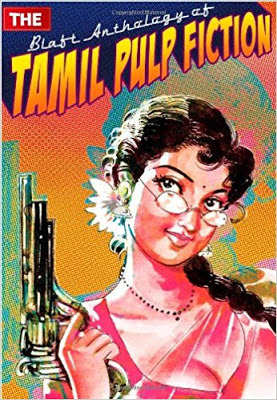
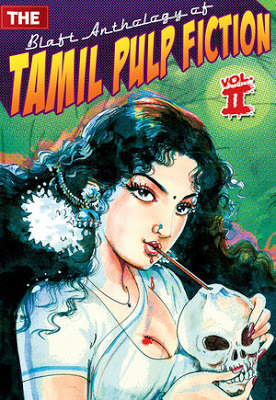 TAMIL PULP—SARIS AND DAGGERS!
TAMIL PULP—SARIS AND DAGGERS!In a previous column, I wrote about the wonderful explosion of Indian Hindi Pulp and its rare but engaging English translations. Tamil Pulp is another strong tradition to come out of India, with several collections also being translated into English. Spoken in four south Indian states, Tamil is the official language of Sri Lanka and Singapore.
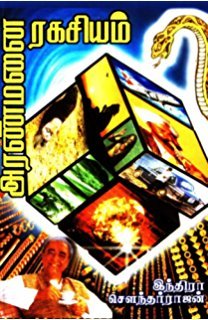 Always considered the language of high culture in India, Tamil has today become the choice of mass market Indian fiction authors, whose stories and style of writing mimic the American pulp magazines, whose heyday ran from the1930s thru the 1950s. In a uniquely Indian twist, these action packed Tamil Pulp stories are often filled with kings, ghosts, and mythological serpents.
Always considered the language of high culture in India, Tamil has today become the choice of mass market Indian fiction authors, whose stories and style of writing mimic the American pulp magazines, whose heyday ran from the1930s thru the 1950s. In a uniquely Indian twist, these action packed Tamil Pulp stories are often filled with kings, ghosts, and mythological serpents. 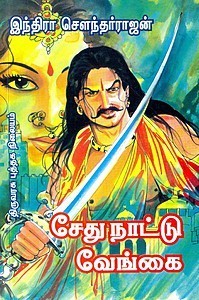 Similar to when the American pulp magazines once boomed, Tamil Pulp novels are currently flourishing in India. They can be spotted on every newsstand and book stall, recognized by their lurid covers—often featuring mustachioed men menacing women in tight nurse's uniforms, knives dripping blood, and lots of cleavage. Clearly, another strong connection to their American forerunners.
Similar to when the American pulp magazines once boomed, Tamil Pulp novels are currently flourishing in India. They can be spotted on every newsstand and book stall, recognized by their lurid covers—often featuring mustachioed men menacing women in tight nurse's uniforms, knives dripping blood, and lots of cleavage. Clearly, another strong connection to their American forerunners.In 2008, California born Rakesh Khanna had returned to India and was living in Chennai, the capital of the Indian state of Tamil Nadu, near the Bay of Bengal. Seeing the barrage of Indian pulp novels exploding around him, Khanna became facinated by the stories. Inspired, Khanna and translator Pritham Chakravarthy co-founded Blaft, an alternative publishing company dedicated to English language versions of Tamil Pulp.
 Blaft has since published three translated anthologies of Tamil Pulp. The books themselves are works of art. The luridly brilliant cover of the first volume features the intriguing figure of a busty, gun-toting, Tamil rose with a knowing look. The following volumes sport similar images. Inside there are striking color reproductions of many Tamil Pulp covers, as well as professionally executed line drawings used to illustrate the stores. Everything is in perfect balanced from the quality of the paper to the binding. Pulp has never looked so good.
Blaft has since published three translated anthologies of Tamil Pulp. The books themselves are works of art. The luridly brilliant cover of the first volume features the intriguing figure of a busty, gun-toting, Tamil rose with a knowing look. The following volumes sport similar images. Inside there are striking color reproductions of many Tamil Pulp covers, as well as professionally executed line drawings used to illustrate the stores. Everything is in perfect balanced from the quality of the paper to the binding. Pulp has never looked so good. The collected stories themselves are riveting and well worthy of their place between the covers. There are mad scientists, hardboiled detectives, robot murderers, desperate housewives, scandalous starlets, sordid, drug-fueled love affairs, vengeful goddesses, and enough racy material to make any mother despair if she caught you reading about them. With titles like, Hold On A Minute I'm In The Middle of A Murder; Sweetheart, Please Die; and Eat Pray Love Kill, any pulp fan is going to be all in.
The collected stories themselves are riveting and well worthy of their place between the covers. There are mad scientists, hardboiled detectives, robot murderers, desperate housewives, scandalous starlets, sordid, drug-fueled love affairs, vengeful goddesses, and enough racy material to make any mother despair if she caught you reading about them. With titles like, Hold On A Minute I'm In The Middle of A Murder; Sweetheart, Please Die; and Eat Pray Love Kill, any pulp fan is going to be all in.GOLDEN RULES FOR TAMIL PULP FICTION
In 1933, Tamil author Sudhandhira Sangu wrote an article called The Secret of Commercial Novel Writing. He laid out the three golden rules:
1. The title of the book should carry a woman's name—and it should be a sexy one like Miss Leela Mohini.
2. Your story must absolutely include a minimum half-dozen lovers and prostitutes, preferably ten or a dozen murders, and few sundry thieves and detectives.
3. You can make money only if you are able to titillate. If you try to bring in any social message, forget it. Beware! You are not going to lure your women readers.
Anyone want to argue with the rules? Didn’t think so...
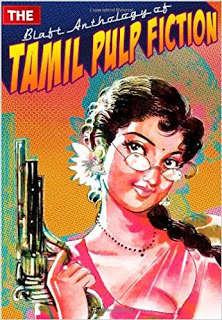 THE BLAFT ANTHOLOGY OF TAMIL PULP FICTION VOL. 1
THE BLAFT ANTHOLOGY OF TAMIL PULP FICTION VOL. 1This anthology features seventeen stories by ten best-selling authors of Tamil crime, romance, science fiction, and detective stories, none of them ever before translated into English, along with reproductions of wacky cover art and question-and-answer sessions with some of the authors. Grab a masala vadai, sit back and enjoy!
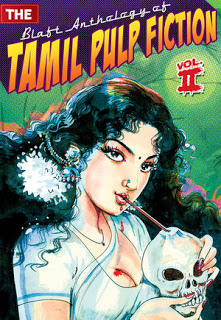 THE BLAFT ANTHOLOGY OF TAMIL PULP FICTION VOL. 2
THE BLAFT ANTHOLOGY OF TAMIL PULP FICTION VOL. 2Selected and translated from the Tamil by Pritham Chakravarthy. Edited by Rakesh Khanna. The follow-up to 2008's successful first collection featuring stories by Indra Soundar Rajan, Medhavi, Jeyaraj, Pushpa Thangadorai, Rajesh Kumar, Indumathi, M.K.Narayanan, and Resakee. A young woman's fascination with blue films leads to a bizarre murder! A bloodline of debauched maharajas falls prey to an evil curse! A beautiful girl uses karate to retrieve a stolen idol! Seven thrilling tales from seven Indian and Singaporean masters of action, suspense, and horror!
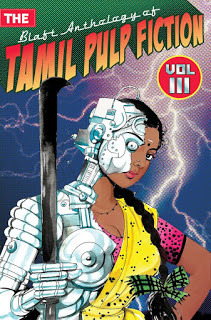 THE BLAFT ANTHOLOGY OF TAMIL PULP FICTION VOL. 3
THE BLAFT ANTHOLOGY OF TAMIL PULP FICTION VOL. 3From the sewers of small-town Tamil Nadu to the drug dens of Khajuraho...From the dance bars of Hyderabad to the exoplanets of Gliese 581...The doyens of Tamil Pulp Fiction bring you six short novels of love...crime...and interstellar terror!
Published on September 28, 2017 19:27
September 24, 2017
WIND RIVER—NOTHING IS HARDER TO TRACK THAN THE TRUTH
 WIND RIVERNOTHING IS HARDER TO TRACK THAN THE TRUTH I’m not sure if I can express how much this film affected me on a level as deep and icy as the Wind River reservation it depicts. Directing from his own script, Taylor Sheridan—last year’s Best Screenplay Oscar winner for the riveting Hell Or High Water—turns Wind River into an unnerving slow burn punctuated by powerful jolts of violence. This mixture gains it’s emotional volatility from the inner core of the journey each character is following. Because of this, it all rings true, as the film’s violence is driven by the characters, not dictated by structured clichés, which demand a visceral kick for false and manipulative validation.
WIND RIVERNOTHING IS HARDER TO TRACK THAN THE TRUTH I’m not sure if I can express how much this film affected me on a level as deep and icy as the Wind River reservation it depicts. Directing from his own script, Taylor Sheridan—last year’s Best Screenplay Oscar winner for the riveting Hell Or High Water—turns Wind River into an unnerving slow burn punctuated by powerful jolts of violence. This mixture gains it’s emotional volatility from the inner core of the journey each character is following. Because of this, it all rings true, as the film’s violence is driven by the characters, not dictated by structured clichés, which demand a visceral kick for false and manipulative validation.The story in Wind River is disarmingly straightforward. Grizzled U.S. Fish and Wildlife agent Cory Lambert is forced to confront his past when he agrees to collaborate with rookie FBI agent, Jane Banner, to solve the harrowing circumstances behind the murder of a young woman on the Wind River Indian Reservation in Wyoming. Expectations raised by these circumstances are negligible—we’ve seen this all before. But in Wind River, the surface murder mystery, and it’s relatively mundane solution, are a smoke and mirrors distraction to allow the true underlying plot to slowly surface like a blade of spring grass piercing hard—packed snow.
 Wind River spins its simple premise on its head, chipping away at what we think we know, to reveal a haunting, metaphor about fatherhood, male bonding, race, poverty, isolation, surviving the unsurvivable, and determination. The final effect comes full circle when a sentence appears on the screen, seconds before fade out, carrying an emotional punch far more visceral than all the prior scenes of violence.
Wind River spins its simple premise on its head, chipping away at what we think we know, to reveal a haunting, metaphor about fatherhood, male bonding, race, poverty, isolation, surviving the unsurvivable, and determination. The final effect comes full circle when a sentence appears on the screen, seconds before fade out, carrying an emotional punch far more visceral than all the prior scenes of violence.Jeremy Renner is terrific as Fish And Wildlife officer, Cory Lambert. He is the keystone of the film, his face and demeanor displaying a constant emotional, internal, concentration. He is never out of step with the elements of either story or the harsh setting. He is always the relentless hunter of predators—in all their forms—who target the weak. There is never a moment where it is unclear what his motivations are or why he takes the actions he intuitively understands are required.
 Renner is well matched by Elizabeth Olson as Jane Banner. Her diminutive stature should have been a casting fail, but she doggedly follows the lead of Emily Blunt, an actress who has honed overcoming her physical size into an art form. Portraying an FBI agent dropped into an alien world, Olson also benefits from a script which doesn’t treat her character with distain. Jane Banner is well aware she is out of her element, but sharp enough, and tough enough, to make the necessary adjustments to her situation without hesitation or consternation.
Renner is well matched by Elizabeth Olson as Jane Banner. Her diminutive stature should have been a casting fail, but she doggedly follows the lead of Emily Blunt, an actress who has honed overcoming her physical size into an art form. Portraying an FBI agent dropped into an alien world, Olson also benefits from a script which doesn’t treat her character with distain. Jane Banner is well aware she is out of her element, but sharp enough, and tough enough, to make the necessary adjustments to her situation without hesitation or consternation.With help from the Tribal Police Chief—another character given a solid anchoring in reality—determining who sent young Natalie running barefoot through the snow to an icy grave, puts Lambert and Banner on a path to truths as chilly and as barren as the desolate environment surrounding them.
As the director, Sheridan stages his climax magnificently. Smoothly blending in a key flashback at exactly the right moment, he reveals the chilling extent of what Natalie endured before she escaped into the frozen wasteland, a warrior alone and without hope. What follows is a bravura sequence, the intensity almost too much to take after the deliberate pacing of what has gone before.
As with Hell Or High Water, Sheridan ends his story not with violence. Instead, he captures us with an emotional elasticity, which goes way beyond the solving of a murder mystery or the catching of a killer. The impact of the raw emotion, which leaves you sitting in your seat until the final credit rolls, comes not from the physical violence, but from the agonizing sincerity of the characters—a dynamic cutting across the fences of race, gender, and societal class as if they were non-existent.
Published on September 24, 2017 11:24
September 21, 2017
STARK HOUSE PRESS NEWSLETTER

 STARK HOUSE PRESSNEWSLETTER, VOLUME 6, NUMBER 7SEPT. 2017
STARK HOUSE PRESSNEWSLETTER, VOLUME 6, NUMBER 7SEPT. 2017September belongs to Peter Rabe. This September, we are reprinting the entire Manny deWitt series, which includes Girl in a Big Brass Bed, The Spy Who Was 3 Feet Tall, and Code Name Gadget. Next year at this time, we will be reprinting his two Mafia novels, War of the Dons and Black Mafia. And in 2019, also in September, we will finish up with New Man in the House and Her High School Lover, the two obscure novels Rabe published under the Marco Malaponte pseudonym back in 1963. Something to look forward to.
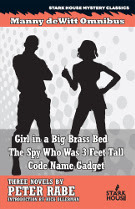 But for now, we’ve got the deWitt novels, which are in a class by themselves. For these books, Rabe decided to try something new, adding an offbeat humor to his stories, and creating a series around an industrial lawyer who is sent on frustrating missions by his capricious boss, Hans Lobbe. Sometimes the humor works, sometimes it doesn’t. As Rick Ollerman points out in his introduction:
But for now, we’ve got the deWitt novels, which are in a class by themselves. For these books, Rabe decided to try something new, adding an offbeat humor to his stories, and creating a series around an industrial lawyer who is sent on frustrating missions by his capricious boss, Hans Lobbe. Sometimes the humor works, sometimes it doesn’t. As Rick Ollerman points out in his introduction: Crimes abound in all three but the books are not really about a crime per se...While Rabe said he admired the work of LeCarré and Deighton, who wrote spy thrillers, deWitt is not a spy. He’s just a lawyer, trying to carry out whatever instructions Lobbe has given him…On the other hand, there are spies in all three of the books, working against deWitt. It takes a master plotter to pull something like this...
So, what we have here are spy satires, sort of, with Rabe putting his main character through the paces while giving us a bit of a wink from the margins. For my taste, Code Name Gadget is the best, with most of the arch humor ditched in favor of a more traditionally gritty spy thriller. As Rick points out, Peter Rabe was anything but conventional and these three novels were a bit of an experiment. Kristofer Upjohn, writing in the Noir Journal, calls the book swift and fun. See if you agree.
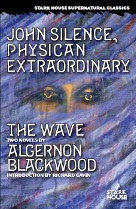 Also this month, we are reprinting two more Algernon Blackwood supernatural classics: John Silence—Physician Extraordinary and The Wave: An Egyptian Aftermath. John Silence collects all the tales of the psychic investigator that were originally published in the 1908 hardback, plus a final story that appeared in Day and Night Stories in 1917 called A Victim of Higher Space.
Also this month, we are reprinting two more Algernon Blackwood supernatural classics: John Silence—Physician Extraordinary and The Wave: An Egyptian Aftermath. John Silence collects all the tales of the psychic investigator that were originally published in the 1908 hardback, plus a final story that appeared in Day and Night Stories in 1917 called A Victim of Higher Space.John Silence was something of a supernatural Sherlock Holmes, aiding his clients by tracking down the origins of their various hauntings and weird manifestations, then dispelling them.
Earlier this year, critic Michael Dirda wrote a long article on Blackwood for The New York Review of Books. You have to subscribe to view NYRB articles online, but here is what he had to say about the John Silence stories: Whatever the background—ghostly invasion, devil-worship, a were-wolf, the depredations of an ancient Egyptian mummy—Blackwood expertly builds up an atmosphere of the otherworldly coupled with the spiritually threatening.
John Silencedefinitely presents Blackwood at his timeless best. The Wave, originally published in 1916, is an expansive story of love and reincarnation played out across the sands of Egypt. Critics at the time were profuse in their praise for this one: “The glory of words, the grandeur that was Egypt, the splendor of a brave and loving human soul—these are the very substance of this fascinating volume.”—New York Times. “A strange and unusual book, full of insight and imagination...the work of a very delicate literary craftsman.”—The Saturday Review
Anthologist and critic Stefan Dziemianowicz provides an excellent introduction to this mammoth volume. No one wrote like Blackwood, and the power of his visions still captivates today. If you’ve never read him, this probably isn’t the best volume to start with, but if you are already familiar with his metaphysical explorations, this is just what you need for a cold winter night.
Stark House Crime Club members will automatically receive the Peter Rabe book. If you would like to receive the Algernon Blackwood book as well, let me know via email.
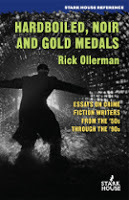 In the meantime, we’ve added a few more ebooks to the ever-growing list: The Goldseekers by W. R. Burnett, Hardboiled, Noir and Gold Medals by Rick Ollerman and Virgin Cay/A Night Out by Basil Heatter. Available now on Kindle!
In the meantime, we’ve added a few more ebooks to the ever-growing list: The Goldseekers by W. R. Burnett, Hardboiled, Noir and Gold Medals by Rick Ollerman and Virgin Cay/A Night Out by Basil Heatter. Available now on Kindle!To visit the Stark House Press website CLICK HERE
Published on September 21, 2017 10:07
September 20, 2017
HINDI PULP—VIMAL!
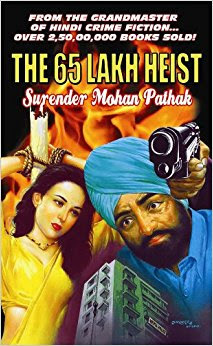
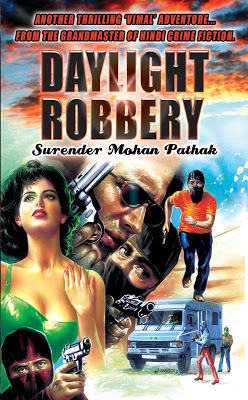 HINDI PULP—VIMAL!
HINDI PULP—VIMAL!I am a big fan of discovering pulp stories from other cultures and countries. Pulp is truly universal, entertaining readers across the globe. Recently, I posted about the South African fotoboekies—a mash-up of action photography and cartoon captioning—including TESSA and LANCE SPEARMAN .
On the heels of those posts, I dropped in on The Yellow Dog Bookstore in Kansas City on the way to catch a plane home to California. There, tucked away in a corner, with its pulpy awesomeness screaming from a gaudy paperback cover, was a mint copy of The 65 Lakh Heist by prolific Indian pulpster Surender Mohan Pathak.
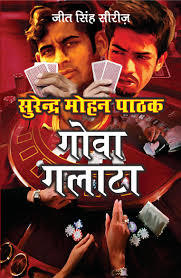 One of six novels by Pathak to be translated into English from the original Hindi, The 65 Lakh Heist is a scorching hot curry mixture of Parker, Wyatt, Nolan, and any other hardcore thief you want to throw in to spice things up. A robbery gone desperately and violently wrong novel, The 65 Lakh Heist, introduces charismatic criminal Vimal to English speaking audiences for the first time. Also known as Sardar, Surender, Singh, Sohal, and another dozen names used to camouflage his identity in the Mumbai underworld, Vimal is a Hindi Robin Hood—a clenched fist of a man constantly on the run from the law and other powerful criminals.
One of six novels by Pathak to be translated into English from the original Hindi, The 65 Lakh Heist is a scorching hot curry mixture of Parker, Wyatt, Nolan, and any other hardcore thief you want to throw in to spice things up. A robbery gone desperately and violently wrong novel, The 65 Lakh Heist, introduces charismatic criminal Vimal to English speaking audiences for the first time. Also known as Sardar, Surender, Singh, Sohal, and another dozen names used to camouflage his identity in the Mumbai underworld, Vimal is a Hindi Robin Hood—a clenched fist of a man constantly on the run from the law and other powerful criminals.  Known as the father of Hindi pulp crime fiction, Surender Mohan Pathak has written close to 300 novels, including 60+ standalone thrillers, 120+ adventures of crime reporter Sunil, 22+ investigations of the Philosopher Detective Sudhir, and 42 of his anti-hero Vimal crime thrillers.
Known as the father of Hindi pulp crime fiction, Surender Mohan Pathak has written close to 300 novels, including 60+ standalone thrillers, 120+ adventures of crime reporter Sunil, 22+ investigations of the Philosopher Detective Sudhir, and 42 of his anti-hero Vimal crime thrillers. While working a full-time job in Delhi with Indian Telephone Industries, Pathak began his writing career in the early 1960s translating Ian Fleming’s James Bond novels and the works of James Hadley Chase into the Hindi language. His first original story, The Man 57 Years Old, was published in a Hindi crime fiction in 1959, followed by his first full length novel, featuring his crime reporter series character Sunil, in 1963.
The character Sunil is a suave and principled investigative journalist working for the daily newspaper Blast. He lives in the metropolitan city of Rajnagar located on the coastline. Both the newspaper and the city are fictional, much the same as the city of Isola in Ed McBain’s 87th Precinct novels.
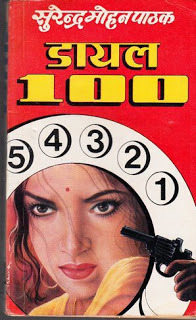 Sunil has a weakness for damsels in distress, who seem to drop into his life with the regularity of the rising sun. In his 30s, Sunil is willing to go any lengths in pursuit of justice. He is aided by his best friend, nightclub owner, Ramakant Malhotra. Every strong character requires an equally strong nemeses. In Sunil’s case it is iron-rodded, incorruptible Inspector Prabhudayal, who is in charge of the homicide division of the Rajnagar Police.
Sunil has a weakness for damsels in distress, who seem to drop into his life with the regularity of the rising sun. In his 30s, Sunil is willing to go any lengths in pursuit of justice. He is aided by his best friend, nightclub owner, Ramakant Malhotra. Every strong character requires an equally strong nemeses. In Sunil’s case it is iron-rodded, incorruptible Inspector Prabhudayal, who is in charge of the homicide division of the Rajnagar Police.Known as the philosopher detective, Sudhir Kumar Kohli is another of Pathak’s series protagonists. Told in the first person, the Kohli tales are diametric opposite of those in the Sunil series. Calling himself The Hammer of Delhi, Kohli constantly manipulates Inspector Devender Kumar Yadav, who has no problem selling his dishonesty. There is one novel in the Kohli series, The Last Goal, which has been translated into English.
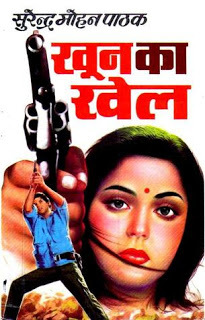 It is Vimal, the scourge of the Mumbai underworld, however, who has become Pathak’s most popular character. It took three novels, two different publishers, and another publisher virtually blackmailed into publishing the third Vimal book, before Pathak’s breakout moment occurred. Once Vimal—the first fictional anti-hero in India—caught the public consciousness, the series shot onto the Indian bestseller lists and brought Pathak’s other characters along for the wild ride.
It is Vimal, the scourge of the Mumbai underworld, however, who has become Pathak’s most popular character. It took three novels, two different publishers, and another publisher virtually blackmailed into publishing the third Vimal book, before Pathak’s breakout moment occurred. Once Vimal—the first fictional anti-hero in India—caught the public consciousness, the series shot onto the Indian bestseller lists and brought Pathak’s other characters along for the wild ride.Other Hindi pulp writers have attempted to emulate Pathak’s success. Several of them have even plagiarize or borrow heavily from Pathak’s books. However, none have achieved Pathak’s unparalleled success.
If you’re looking for something different yet familiar to spice up your pulp reading, Vimal is the man to see for the job.
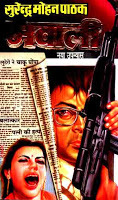
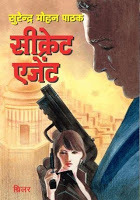
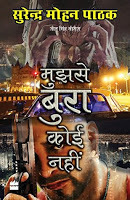
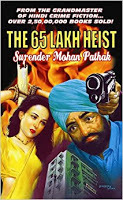
THE 65 LAKH HEIST
The book that launched a whole genre of anti-hero Hindi crime fiction—Vimal never wanted to get involved in the heist. But he's been roped in and only hopes he can finish the job without getting caught. His partners have other plans, however, and soon Vimal finds himself playing a deadly game with the kingpin of the Punjab underworld...First published in 1977 and reprinted over fifteen times, The 65 Lakh Heist is the first of Surender Mohan Pathak's hugely popular Vimal series to be translated in to English.
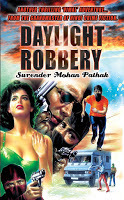 DAYLIGHT ROBBERY
DAYLIGHT ROBBERYAn explosive plan one bullet away from disaster. A grizzled old card shark who wants to pull one last job before he retires from his life of crime. A security officer with a dangerous penchant for gambling. A hot-blooded beauty who judges a man by the thickness of his wallet. And Vimal—a man so desperate for a future, he's willing to commit Daylight Robbery.
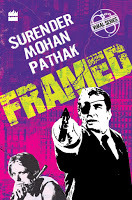 FRAMED
FRAMEDVimal, a man with many faces and numerous names, was an escaped convict fit to be recaptured and hanged. But, after many years, Vimal has decided to abandon his past and settle down as a family man. But his nemesis Mayaram Bawa comes back from the grave to destroy him, his sole ambition being to go down in history as the man who tamed the invincible Vimal. From the bestselling forty-novel strong Vimal series by the king of crime fiction Surender Mohan Pathak, comes Framed, a page-turner you won’t be able to resist.
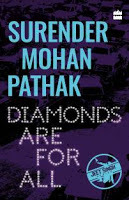 DIAMONDS ARE FOR ALL
DIAMONDS ARE FOR ALLTaxi driver Jeet Singh is cruising for fare when a man being tailed by a bunch of goons blocks his way. Entrusting Jeet Singh with a briefcase full of secret, classified government documents, the man asks Jeet to deliver them instead of a huge sum to a girl in Jogeshwari. The man than jumps from Jeet Singh’s moving taxi. The next morning, the man’s dead body is found by the railway track in a Mumbai suburb. To complicate matters, Jeet Singh finds the girl he was supposed to deliver the briefcase to is also dead. When Jeet Singh opens the briefcase, a free-for-all over diamonds worth millions is set into motion. From the badshah of crime writing comes another blockbuster novel, Diamonds are for All.
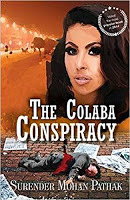 THE COBRA CONSPIRACY
THE COBRA CONSPIRACYJeet Singh’s ex-girlfriend Sushmita’s rich industrialist husband is brutally stabbed to death. Her stepchildren destroy all evidence of her marriage to their slain father, and implicate her in the murder along with Jeet Singh. Known to be able to open any safe in the country, Jeet Singh takes it upon himself to clear their names and solve the murder. Voted the most popular book of 2014 in Indian Writing, Cobra Conspiracy is a whodunit to keep you guessing all the way.
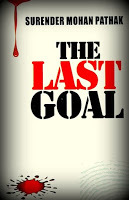 THE LAST GOAL
THE LAST GOALThe moment I had my first glance of Mathur’s mansion, I had to concede Madan had not exaggerated while describing his riches. It was a palatial structure fit only to be abode of a king. Money is God for a poor man. But for a rich man, the role of money is very restricted. In the life of a rich man, a stage comes when money becomes a useless commodity. When its only utility left is to make it an instrument of earning more money. A rich man laments God didn’t bestow him with ten mouths and twenty stomachs, as he cannot sip silver as drink, he cannot eat gold as food, cannot chew diamonds or rubies or pearls. That might be the reason the men with money make the most vulgar display of it in raising a mansion and in the marriage of their children where no expenditure is ever enough.
Published on September 20, 2017 22:38
CONAN THE POLICE PROCEDURAL
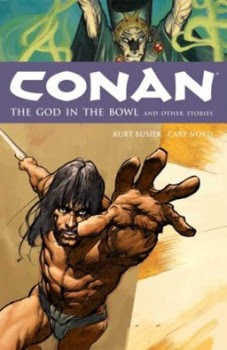
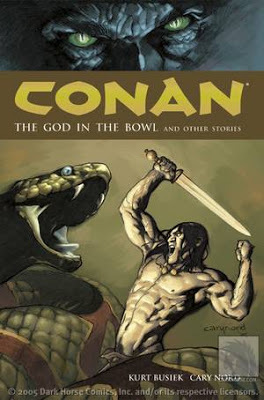 With the permission of my friend and respected columnist Bob Byrne (THE PUBLIC LIFE OF SHERLOCK HOLMES), I reposting his recent
BLACK GATE
column, which takes a refreshing look at one of Robert E. Howard's most maligned Conan stories from a totally different perspective...Was REH the true father of the police procedural? Read on...
With the permission of my friend and respected columnist Bob Byrne (THE PUBLIC LIFE OF SHERLOCK HOLMES), I reposting his recent
BLACK GATE
column, which takes a refreshing look at one of Robert E. Howard's most maligned Conan stories from a totally different perspective...Was REH the true father of the police procedural? Read on...CONAN THE POLICE PROCEDURAL
Reportedly, Ernest Hemingway bet Howard Hawks the director couldn’t make a good movie out of his worst book. Hawks took the bet and we ended up with Humphrey Bogart in To Have and Have Not (it’s not Bogie’s best, but I vote Hawks the winner of the bet). Suppose I told you I could show you that one of what’s commonly considered among the worst Conan stories isn’t really that bad—and that it’s a pre-genre police procedural? Ready to take on the challenge?
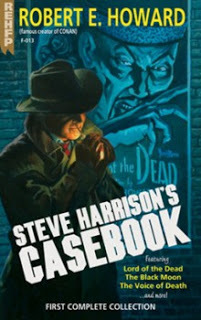 In 2015, Black Gate‘s Discovering Robert E. Howard series showcased the breadth and diversity of REH’s writings. Boxing stories, westerns, science fiction, Solomon Kane, El Borak: Howard was an immensely talented author who wrote in a variety of genres. My first entry in the series was about Steve Harrison (
CLICK HERE
), Howard’s take on the hardboiled private eye with a weird menace twist. As you can read in that essay, Howard didn’t care for the genre and he abandoned it almost as quickly as he entered it. Today, I’m going to look at his lone police procedural. Yep—Robert E. Howard wrote a police procedural before the term was even in use. And it features Conan!
In 2015, Black Gate‘s Discovering Robert E. Howard series showcased the breadth and diversity of REH’s writings. Boxing stories, westerns, science fiction, Solomon Kane, El Borak: Howard was an immensely talented author who wrote in a variety of genres. My first entry in the series was about Steve Harrison (
CLICK HERE
), Howard’s take on the hardboiled private eye with a weird menace twist. As you can read in that essay, Howard didn’t care for the genre and he abandoned it almost as quickly as he entered it. Today, I’m going to look at his lone police procedural. Yep—Robert E. Howard wrote a police procedural before the term was even in use. And it features Conan!The general consensus is that Howard hit the mark with his fourth Conan story, The Tower of the Elephant, published in March of 1933. His first was The Phoenix on the Sword, which appeared in Weird Tales in December of 1932 and was a rewrite of an unpublished Kull story, By This Axe I Rule. Farnsworth Wright, editor of Weird Tales, rejected the second, The Frost Giant’s Daughter, which to me, reads more like a chapter in a longer work than a self-contained story.
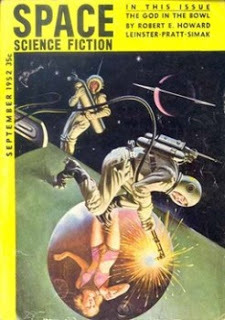 The God in the Bowlwas probably written in early 1932 and was Howard’s third Conan story. Wright rejected this one as well and it did not see print in any form until an edited version by L. Sprague de Camp was published in 1952’s Space Science Fiction, Volume 1, Number 2 (the story has nothing to do with either space or science fiction). De Camp did less chopping on this one than most of his Conan edits, but fans could finally read Howard’s original text in Donald Grant’s The Tower of the Elephant in 1975.
The God in the Bowlwas probably written in early 1932 and was Howard’s third Conan story. Wright rejected this one as well and it did not see print in any form until an edited version by L. Sprague de Camp was published in 1952’s Space Science Fiction, Volume 1, Number 2 (the story has nothing to do with either space or science fiction). De Camp did less chopping on this one than most of his Conan edits, but fans could finally read Howard’s original text in Donald Grant’s The Tower of the Elephant in 1975.He next wrote his world-shaping essay, The Hyborian World, which many feel gave him a framework that contributed to The Tower of the Elephantbeing such a fine story.
Okay—moving on from Conan for a bit...
POLICE PROCEDURALS, EH?
It’s easy to track the beginning of the hard-boiled genre to Carroll John Daly and Dashiell Hammett in the pages of Black Mask Magazine in 1922 and 1923. The police procedural’s beginning is not quite so clearly delineated. You could argue for novels here and there, like 1868’s The Moonstone, by Wilkie Collins. Sergeant Cuff is a police detective, but I wouldn’t call this a procedural.
Georges Simenon’s Inspector Maigret—which you know is currently being adapted in a series of TV movies because you used to love The Public Life of Sherlock Holmescolumn here at Black Gate ( CLICK HERE )—who first appeared in 1931, is a policeman, but he essentially functions as an independent protagonist. There were novels here and there, such as Lawrence Treat’s V as in Victim and Hillary Waugh’s Last Seen Wearing, but these came after The God in the Bowl.
Police procedurals actually gained their footing due to radio shows such as Dragnet and films like The Street With No Name (a classic). Today, police procedurals are far more commonly linked to television shows than books.
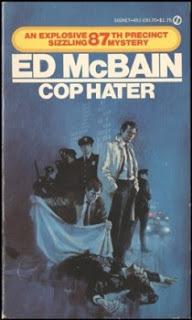 Ed McBain (Evan Hunter) began his popular 87th Precinct series in 1956 and that’s as good a point as any to identify as the establishment of the police procedural in fiction. A few years later, Per Wahloo and Maj Sjowall created Danish police detective Martin Beck, which further entrenched the genre. Tony Hillerman, who I have previously written about (
CLICK HERE
), wrote procedurals featuring the Navajo Tribal Police.
Ed McBain (Evan Hunter) began his popular 87th Precinct series in 1956 and that’s as good a point as any to identify as the establishment of the police procedural in fiction. A few years later, Per Wahloo and Maj Sjowall created Danish police detective Martin Beck, which further entrenched the genre. Tony Hillerman, who I have previously written about (
CLICK HERE
), wrote procedurals featuring the Navajo Tribal Police.But in 1932, Robert E. Howard was, once again, ahead of his time.
The police procedural differs from the detective-driven mystery, whether that private investigator is Sherlock Holmes or Sam Spade. In the classical and hard-boiled schools of mystery fiction, the detective worked outside of the authorities, usually holding back information from the police.
We’re used to seeing the private eye/police officer dichotomy: Sherlock Holmes/Inspector Lestrade, Sam Spade/Lt. Dundee, Adrian Monk/Captain Stottleymer, Hercule Poirot/Inspector Japp, et al. The detective solves the crime while the police follow along, never able to work things out themselves. In the police procedural, it’s the cops that go through the step-by-step process of breaking a case.
In a procedural, the detective is a member of the force and they must follow the rules and regulations required of them. Though, of course, those can vary by time and locale. In one of the early Nero Wolfe books (I know, not a police procedural), Archie watches someone he turned in to the police get worked over in the basement by a cop. That was the norm of the time, though Rex Stout was less obvious about it in future stories.
The policeman doesn’t solve the crime by knowing what kind of mud can only be found in a certain part of town, and he generally doesn’t make some brilliant deduction a normalinvestigator couldn’t. Crime scenes are examined, questions are asked and set routines are followed. I think of it as grunt work. It’s not called a procedural for nothing.
The stories aren’t just about the policemen and the processes they go through to solve a crime, but they’re about the world they work in, from the station house to the streets they protect. In that way, the genre does resemble the hard-boiled school, which was as much about the mean streets the detectives strode down as about the detectives themselves. We certainly get a look at what justice was like in Conan’s Nemedia.
So, can we look at The God in the Bowl, a Conan story, and see the elements of a police procedural? Yes, we can. And with a weird menace element, of course. We’re talking about Robert E. Howard here.
A NIGHT AT THE MUSEUM—SPOILER ALERT
We’re about to discuss a 17-page story. If you want to go read it ( CLICK HERE ), it won’t take you long. The nature of this post is that it is essentially a spoiler, so you’re on your own as far as responsibility goes. Here’s the opening:
Arus the watchman grasped his crossbow with shaky hands, and he felt beads of clammy perspiration on his skin as he stared at the unlovely corpse sprawling on the polished floor before him. It is not pleasant to come upon Death in a lonely place at midnight.
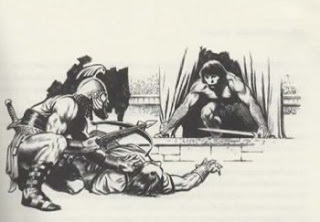 Man! I read a lot, and nobody writes like REH did. Arus is the night guard at Kallian Publico’s Temple (museum), in the Nemedian city of Numalia. Now, we all know how creepy museums seem at night. Here we’ve got a hired sword unexpectedly coming across an unlovely corpse. And not just any body, this is Kallian himself.
Man! I read a lot, and nobody writes like REH did. Arus is the night guard at Kallian Publico’s Temple (museum), in the Nemedian city of Numalia. Now, we all know how creepy museums seem at night. Here we’ve got a hired sword unexpectedly coming across an unlovely corpse. And not just any body, this is Kallian himself.From the description, it appears that Kallian had been poisoned or strangled. Before Arus can get his mental footing, a huge, nearly naked, young Conan comes out of an adjoining room. Arus, likely all but peeing in his pants at the sight of this huge savage, accuses Conan of killing Kallian and pulls the hanging rope that sounds an alarm outside.
THE OFFICIAL FORCE TAKES OVER
Almost immediately, five men of the city watch, armed to the teeth, enter the room, led by a sixth. This last is Demetrio, Chief of the Inquisitorial Council. The watch defers to him, including their leader, Dionus, the Prefect of Police. For all intents and purposes, Demetrio is a member of the watch for this story.
There are three policemen of note in this story: Demetrio, Dionus and another watchman named Posthumo. All the others are merely armed fodder. Think of them as red-shirted security officers from Star Trek.
Dionus immediately establishes himself as a stereotypical bully. When asked if he killed Kallian, Conan shakes his head but refuses to answer aloud. When berated by Demetrio, Conan replies that he is no dog. Dionus exclaims:
“Oh, an insolent fellow! An independent cur! One of those citizens with rights, eh? I’ll soon knock it out of him! Here, you! Come clean!”
We already know what kind of policeman he is.
Demetrio steps in and takes charge of the questioning. He asks several relevant questions of the museum guard, Arus. Dionus breaks in, showing his true colors again.
“Why go to all the trouble of questions and speculations. It’s much easier to beat a confession out of a suspect. Here’s our man, no doubt about it. Let’s take him to the Court of Justice. I’ll get a statement if I have to mash his bones to a pulp.”
Conan is not intimidated by the official force. When Demetrio asks what he has to say, Conan replies:
“That any man who touches me will quickly be greeting his ancestors in hell.”
When Demetrio begins to threaten Conan, he is cut off abruptly by the Cimmerian.
“Save your bullying for the fools who fear you. I’m no city-bred Nemedian to cringe before your hired dogs. I’ve killed better men than you for less than this.”
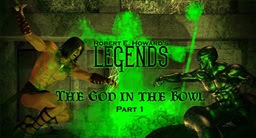 We have clearly established three characters: the good cop, the bad cop and the thief. Dionus reminds me of Lieutenant Com Noonan of the State Police in the Nero Wolfe story, Door to Death. His primary conversational contribution is to let Wolfe and Archie know that if it were up to him he would take them to the state barracks as material witnesses and presumably work them over.
We have clearly established three characters: the good cop, the bad cop and the thief. Dionus reminds me of Lieutenant Com Noonan of the State Police in the Nero Wolfe story, Door to Death. His primary conversational contribution is to let Wolfe and Archie know that if it were up to him he would take them to the state barracks as material witnesses and presumably work them over.Dionus is a one-dimensional heavy who serves to show how little justice the common person could expect to receive from the police of Numalia. He is a loudmouthed bully and he has that role only in the story.
As we’ll see, Demetrio is actually a competent policeman. He asks relevant questions, reconstructs events and leads the investigation. Up to a point, it’s reasonable to think of him as the story’s protagonist.
There’s one other watch member we’ll encounter, Posthumo. He is merely a rank and file version of Dionus, contributing nothing beyond bullying a helpless citizen. Dionus could have served the role just as well. I’m not sure why Howard included Posthumo, other than to show that the men serving under Dionus are no better than he is.
YOU DON’T BULLY A CIMMERIAN
Conan is, of course, the thief. He played that role in this story and the next, The Tower of the Elephant. Dionus is convinced he is the murderer. Demetrio, who is willing to look at the facts and then come to a conclusion, isn’t so sure. Demetrio is Holmes to Dionus’ Lestrade (actually a bit unfair to Lestrade, but you get the point).
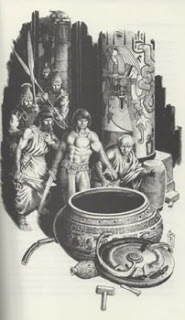 Back to the story—The situation is tense. The rank and file police expect Demetrio to order them to seize the barbarian. I imagine they aren’t too keen on the prospect. But the Inquisitor knows that there will be much bloodshed if they try to take Conan by force. It might even go the wrong way. Also, he still has doubts that Conan is guilty. He is clearly a much better cop than Dionus. He continues the discussion, getting Conan to recount his movements.
Back to the story—The situation is tense. The rank and file police expect Demetrio to order them to seize the barbarian. I imagine they aren’t too keen on the prospect. But the Inquisitor knows that there will be much bloodshed if they try to take Conan by force. It might even go the wrong way. Also, he still has doubts that Conan is guilty. He is clearly a much better cop than Dionus. He continues the discussion, getting Conan to recount his movements.When Arus makes a clueless statement about Cimmerians, Demetrio dismisses him out of hand. Demetrio continues the interrogation, coaxing Conan into admitting that he had come to steal something from the museum. He’s doing a pretty good job of investigating.
Dionus, always consistent, jumps in again.
“And to kill Kallian Publico. By Mitra, we’ve hit it. Grab him, men! We’ll have a confession before morning!”
Dionus has a role to play, but he certainly is a cardboard cutout.
Conan whips out his sword and it’s clear he is not intimidated.
“Back if you value your dog lives!,” he snarled, his blue eyes blazing. “Because you dare to torture shop-keepers and strip and beat harlots to make them talk, don’t think you can lay your fat paws on a Hillman! I’ll take some of you to hell with me. Fumble with your bow, watchman—I’ll burst your guts with my heel before the night’s work is over!”
Conan was raised in the bleak northlands of Cimmeria. He may be a thief, but he is also a scarred warrior who will bow before no man. Dionus (and Posthumo, who we’ve not actually met yet) are completely ineffectual versus him. What we have is a contest between Demetrio and Conan. That is at the heart of this story.
Demetrio wants to solve a murder and he has corralled a thief (you can’t exactly call Conan capturedat the moment)—there may be two totally unrelated crimes here.
The Inquisitor orders Dionus to call off his men, telling the prefect he’s not convinced Conan is the murderer. He also whispers, “You fool, wait until we can summon more men, or trick him into laying down his sword.” Demetrio wants to keep things on an intellectual plain, not a physical one. As we’ll see, that’s a savvy approach.
POLICEMAN AT WORK
After failing to get Conan to lay down his sword, Demetrio wonders why the barbarian would strangle Publius, instead of using his sword.
Dionus contributes nothing useful as usual, muttering, “Perhaps to divert suspicion.”
Again, we’re reminded of the smart private eye and the less intelligent police officer. Except here it’s the smart cop and the dumb cop. Demetrio continues gathering evidence to weigh against Conan’s story and tries to figure out the likely course of events which transpired.
Demetrio then feels the body to determine the time of death and analyzes Conan’s timetable, establishing that either the man is innocent or lying.
Demetrio is clearly the only actual detective in the story, even though he isn’t in fact a policeman. After speculating on the possible murder weapon, he recreates Kallian’s movements during the attack on the dead man. Throughout the story, he is the only one to impress the reader with his intelligence and acumen.
Dionus is growing boring to the reader, tossing in, “And if the heathen isn’t the murderer, where is he?” You can almost tune him out.
Demetrio hears a chariot stopping nearby and orders the guards to bring the driver, as well as Kallian’s chief clerk, who lives nearby. Enaro, Publico’s charioteer, is a powerfully built dark-skinned man and a debtor slave. He shows no remorse at his master’s demise.
Promero, a small, timid looking man, is a spineless clerk and cries out, “Oh, I knew evil would come of this,” when he sees Kallian’s body. Instead, yell out, ‘Please beat me brutally until I tell you what I know.
Enaro accounts for his whereabouts, while Promero is obviously lying. Demetrio lets Dionus loose on the clerk and the Prefect signals to Posthumo, one of his men. Enaro comments that Posthumo gouged out a girl’s eye in the Court of Justice because she wouldn’t give information incriminating her lover.
Posthumo makes Dionus look like an intellectual.
“I always get what I go after!” bellowed the guardsman, the veins in his thick neck swelling, and his face growing purple….”Speak up, you rat!”
He then slaps Promero terrificallyon one side of his face, then the other, after which he tosses him to the floor and kicks him. The broken clerk begs him to stop, offering to tell all that he knows.
“Then get up, you cur,” roared Posthumo, swelling with self-importance.
Of course, Dionus has to show his colors again. He glances at Conan.
“You see what happens to those who cross the police?”
The barbarian is as impressed as one would expect.
The Cimmerian spat with a sneer of cruel contempt for the moaning clerk. “He’s a weakling and a fool,” he growled. “Let one of you touch me and I’ll spill his guts on the floor.
Early Conan was a bit less eloquent than he would later be.
“Are you ready to talk?” asked Demetrio tiredly. He found these scenes wearingly monotonous.
THE TALKING HEAD
I think a major weakness in the story is that Promero gives a long exposition in which we learn that an ancient, round sarcophagus had arrived from Stygia, to be delivered to Kalanthes, a priest of Ibis. Of course, Ibis is an enemy of Set, so something seems odd.
Kallian was determined to open the sarcophagus and steal whatever treasure was inside. He would hide the treasure, then discover the theft the following morning, having the Arus the guard crucified after accusing him of being the inside man for the theft.
It definitely moves the story forward, in that we know why Kallian was there after hours and gives us an actual object to focus the investigation on. But the police gain this information by doing nothing more than beating up a meek accountant. It is too easy. It may well have been a necessary device, but it doesn’t feel up to the standards of Howard.
SOMEBODY NEEDS TO BE ARRESTED
Dionus orders a search of the entire museum, as he believes that if Conan isn’t the murderer, the killer must still be on the premises. This is actually good police work and I’m surprised Demetrio hadn’t thought of it earlier. Of course, Dionus’ motivation is to hang the crime on Conan, but it doesn’t alter the fact that it was a logical and called-for step. Sadly, this is his lone moment of competence.
The Prefect also makes an interesting point about Nemedian justice—Killing a commoner results in one being sentenced to hard labor in the mines. Killing a tradesman is a hanging offense. And killing rich man like Kallian results in burning (presumably a public spectacle). Justice isn’t blind—but she’s winking one eye.
Conan admits someone gave him a map of the museum and told him where to find a Zamorian diamond goblet, but he refuses to name his employer.
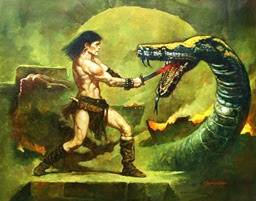 An unnamed policeman says he has found the murder weapon, a thick, black, splotched cable, in the next room. But it’s gone when they go in to see it and Demetrio dismisses the man’s claim. Friends have told me they figured it out at this point, but I didn’t. I probably should have, as Howard has played fair and given us all the clues needed to solve Kallianâ’s killing. Guess I didn’t have my deerstalker on (I do have one, naturally).
An unnamed policeman says he has found the murder weapon, a thick, black, splotched cable, in the next room. But it’s gone when they go in to see it and Demetrio dismisses the man’s claim. Friends have told me they figured it out at this point, but I didn’t. I probably should have, as Howard has played fair and given us all the clues needed to solve Kallianâ’s killing. Guess I didn’t have my deerstalker on (I do have one, naturally).Demetrio seems to be tiring of the whole evening and is ready to go home.
“No, I tell you, Conan didn’t commit the murder. I believe the real murderer killed Kallian to secure whatever was in the Bowl, and is hiding now in some secret nook in the Temple. If we can’t find him, we’ll have to put the blame on the barbarian, to satisfy Justice...”
There is absolutely an essay on justice, policemen, and culture in this short speech from Demetrio, which deserves to be explored by somebody up to the task.
However, something happens and Demtrio’s comments are cut off. But, I think, this is a really notable moment in the story, and—again—I’d like to see a real Howard scholar (as opposed to me) explore it.
Demtrio has arguably been the protagonist thus far. He’s certainly the only admirable character from the law enforcement ensemble. Since Conan has just stood there, said he didn’t kill Kallian and has threatened to kill anybody who bothers him, he’s not exactly the story’s center.
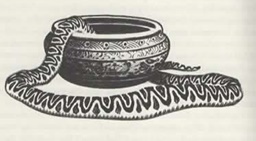 But there is no way we can make Demetrio the hero of the story now. He’s certain Conan didn’t commit the murder, but hey, somebody’s gotta hang. And if Demetrio can’t find who actually killed the museum owner, well, then, the foreigner caught in the wrong place at the wrong time will have to do. Demetrio isn’t a good(ish) guy anymore. He’s a corrupt policeman with almost absolute authority (standard villain hallmarks). And he’s going to railroad an innocent (well, of the crime at hand, anyways) man to execution. The whole story has pivoted at this moment.
But there is no way we can make Demetrio the hero of the story now. He’s certain Conan didn’t commit the murder, but hey, somebody’s gotta hang. And if Demetrio can’t find who actually killed the museum owner, well, then, the foreigner caught in the wrong place at the wrong time will have to do. Demetrio isn’t a good(ish) guy anymore. He’s a corrupt policeman with almost absolute authority (standard villain hallmarks). And he’s going to railroad an innocent (well, of the crime at hand, anyways) man to execution. The whole story has pivoted at this moment.There absolutely is an essay on justice, policemen and culture in th short speech above from Demetrio that should be explored by somebody up to the task.
OKAY—BACK TO THE SCENE
Promero comes back into the room and reveals the Bowl bears the mark of the Stygian sorcerer, Thoth-amon. The master of the dark arts had obviously sent some deadly horror to kill Kalenthes, his enemy, and Kallian released it.
Howard shows a spark of humor here as Promero’s wild-eyed hysteria is cut short:
“You gibbering fool!” roared Dionus disgustedly, striking him heavily across the mouth. Dionus was a materialist, with scant patience for any speculations.
Dionus then tells Demetrio the only option is to arrest Conan, who interrupts him and says that he saw a long dark shadow slithering across the floor of the Bowl room. Promero panics again and Posthumo tosses him into the other room where the shadow was seen.
Dionus seems to be ready to arrest Conan, who in turn is ready to spill some blood, when a guardsman enters, dragging a richly dressed man who turns out to be Aztrias Petanius, the city governor’s nephew. Aztrias explains he had been passing by after a night of revelry and Dionus tells him they have the man who is doubtless guilty.
A LITTLE PERSPECTIVE ON THIS STORY IN THE CONAN CANON
Quite a few of my REH friends and acquaintances don’t care for this story, including Black Gate Managing Editor, Howard Andrew Jones. As far as Conan stories go, it’s been rather dull on the action scale. A guard found the owner of a museum murdered. Conan had been there to steal something and when the police were summoned, he was the only suspect. Up to this point, there’s been a whole lot of standing around, talking. We haven’t even seen any blood spilled (the murdered man was strangled).
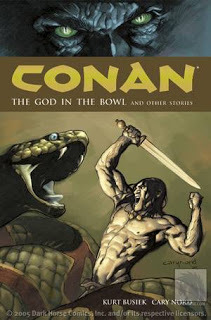 I’m not saying looking at The God in the Bowl as a pre-genre police procedural makes it a Robert E. Howard classic. However, when putting it within the proper context, what you’ve got is a workmanlike procedural with a couple of interesting characters—Demetrio and Conan. And things are absolutely about to pick up. What Howard has done to this point is set up a blistering Conan action scene, leading to a supernatural Hyborian finale. Instead of being bored with a non-action Conan story so far, credit Howard for having managed to enmesh Conan in a police procedural, which is about to shift gears into an action sword and sorcery tale.
I’m not saying looking at The God in the Bowl as a pre-genre police procedural makes it a Robert E. Howard classic. However, when putting it within the proper context, what you’ve got is a workmanlike procedural with a couple of interesting characters—Demetrio and Conan. And things are absolutely about to pick up. What Howard has done to this point is set up a blistering Conan action scene, leading to a supernatural Hyborian finale. Instead of being bored with a non-action Conan story so far, credit Howard for having managed to enmesh Conan in a police procedural, which is about to shift gears into an action sword and sorcery tale.AND THINGS ARE ABOUT TO GET BUSY
“A vicious looking brute! How can any doubt his guilt? I have never seen such a villainous countenance before.”
And now we have a very angry barbarian on our hands. A standard trope in the crime caper is having the thieves fall out. Conan reveals it was Aztrias who hired him to steal the goblet and who had been waiting outside to receive it from Conan. He demands Aztrias vouch for his entry into the museum, eliminating him as a murder suspect.
Demetrio, a practical man, tells Aztrias if Conan’s assertions are true, the attempted theft can be hushed up and while Conan is due ten years of hard labor for house-breaking, an escape can be arranged. Everything will be kept quiet for the governor’s nephew.
A man’s life can rest on one crucial decision. Aztrias has two very clear choices. He went with:
“I know him not. He is mad to say I hired him. Let him take his just desserts. He has a strong back and the toil in the mines will be well for him.”
He’d probably like to have that one back, though he doesn’t have long to rue his decision.
Conan drops his head, seemingly resigned to his fate. Keep in mind, there has been zero action in the story so far. I mean, none. But now, we get the Robert E. Howard we normally associate with Conan (again—this was only his third try at writing the character).
He struck with no more warning than a striking cobra; his sword flashed in the candle light. Aztrias shrieked and his head flew from his shoulders in a shower of blood, the features frozen in a white mask of horror. Catlike Conan wheeled and thrust murderously for Demetrio’s groin. The Inquisitor’s instinctive recoil barely deflected the point which sank into his thigh, glanced from the bone and ploughed out through the outer side of the leg. Demetrio went to his knee with a groan, unnerved and nauseated with agony.
Wow! As I’ve said many times before, I think Robert E. Howard remains the best fantasy writer I’ve ever read. This story just absolutely exploded. In the next paragraph, Conan slices off one of Dionus’ ears and gouges out one of Posthumo’s eyes. After, he nearly puts his sandaled foot through Arus’ stomach and then he kicks him in the mouth.
The wretch screamed through a ruin of splintered teeth, blowing bloody froth from his mangled lips.
I also like how Posthumo—who had gouged out a woman’s eye because she didn’t give him some information he wanted (likely he was demanding false testimony)—has his own eye gouged out by Conan. That’s irony.
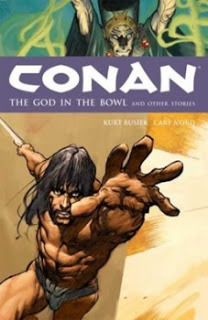 We are done with the police procedural—it’s over. Normally, at this stage (well, actually, before the sword attack), the police would arrest the culprit. We have moved into the realm of the sword and sorcery story now. Howard has given us a violent melee combat and now he will move us forward and solve the mystery. And to do so he’ll go deep into the history of Stygia, the Egyptian-like culture built on dark sorcery.
We are done with the police procedural—it’s over. Normally, at this stage (well, actually, before the sword attack), the police would arrest the culprit. We have moved into the realm of the sword and sorcery story now. Howard has given us a violent melee combat and now he will move us forward and solve the mystery. And to do so he’ll go deep into the history of Stygia, the Egyptian-like culture built on dark sorcery.A terrifying scream comes from the next room and Promero, sobbing like an idiot, comes into the room. All action is arrested. Again, Howard knows how to put words together:
All halted to stare at him aghast—Conan with his dripping sword, the police with their lifted bills, Demetrio crouching on the floor and striving to staunch the blood that jetted from the great gash in his thigh, Dionus clutching the bleeding stump of his severed ear, Arus weeping and spitting out fragments of broken teeth—even Posthumo ceased his howls and blinked whimpering through the bloody mist that veiled his half-sight.
I mean, c’mon. That is some fantastic writing!
TIME TO WRAP THINGS UP
Promero babbles about a god with a long neck and dies. Horror sweeps over those in the room and they all flee, with the exception of Conan. Posthumo is knocked down and trampled by his colleagues, but crawls along after them. I find it a satisfying exit for the thuggish policeman. The group hurtles into the street, panicking the guards outside, who also flee.
Conan, alone, strides into the next room and above a screen sees the inhumanly beautiful face of one of the god-men who ruled Stygia long ago. Conan leaps and slashes with his sword. The head topples to the side and the snake-body it had been attached to writhes and thrashes until it too dies. Conan has slain one of the ancient Children of Set (I think: the text is a little confusing to me). Even the hardy barbarian has seen too much and he flees from the city.
READY TO CALL IT A POLICE PROCEDURAL?
Just as Howard had written hard boiled private eye stories with a Sax Rohmer flavor via his Steve Harrison tales, he actually wrote a police procedural (before the term existed) with Conan. Demetrio seems to be a fairly honest cop, trying to solve the murder of a prominent citizen. While he is the most intelligent person in the story, his professional ethics are a bit lacking.
Dionus and Posthumo are the crooked bully cops who beat confessions out of suspects. Aztrias is the rich citizen largely above the law, though not beyond savage justice. Conan is the common thief abused by everyone of any stature. Arus is the private officer looked down upon by the official force.
Demetrio tries to work out what really happened using traditional methods. He doesn’t have flashes of insight or draw on exotic knowledge. Sadly, his inclination to cut corners with justice puts an innocent man on edge and the sudden outburst of violence is both breathtaking and unfortunate for almost every named character.
This is very much a closed-environment procedural, which I think it could be turned into a play. All of the action takes place in a hallway and one adjacent room. Combined with the copious amounts of talking, this is likely a major reason why it seems like most Conan fans do not care for this story. It is quite different from every other one Howard wrote.
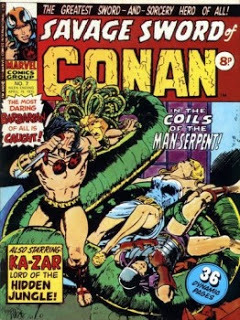 But The God in the Bowl can be considered a very early police procedural, written over two decades before Ed McBain began to dominate the genre. As such, the story works better than merely as an early Conan tale. As I mentioned in my Steve Harrison article, Howard did not like the hard-boiled genre and abandoned it quickly. Likewise, I am not aware of any other story he wrote that could be classified as a police procedural. In fact, the very next Conan story was a crime caper.
But The God in the Bowl can be considered a very early police procedural, written over two decades before Ed McBain began to dominate the genre. As such, the story works better than merely as an early Conan tale. As I mentioned in my Steve Harrison article, Howard did not like the hard-boiled genre and abandoned it quickly. Likewise, I am not aware of any other story he wrote that could be classified as a police procedural. In fact, the very next Conan story was a crime caper.As we highlighted here at Black Gate with our Discovering Robert E. Howard series, the man had an amazing breadth. With this look at The God in the Bowl, we can add one more category to his amazing diversity.
With the atmospheric opening, the constant theme of the civilized man bullying the primitive savage, the character of Demetrio, the lore of ancient Hyboria, the inclusion of Thoth-Amon, the explosiveness of the action and the exotic finish, The God in the Bowl might not be one of the best Conan stories, but it isn’t as bad as commonly credited. I believe it can stand up against its predecessor, The Frost Giant’s Daughter. Of course, both were rejected by Weird Tales and neither was published during Howard’s sadly shortened lifetime…
Published on September 20, 2017 10:47
OUT OF THE SHADOWS—JAMES MCKIMMEY
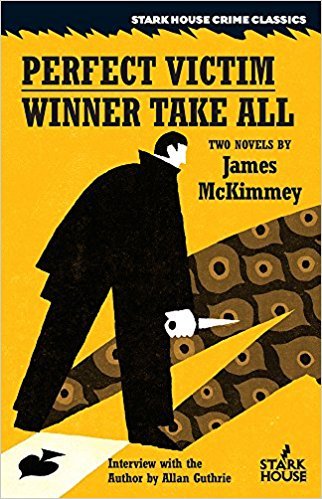 OUT OF THE SHADOWSJAMES MCKIMMEY
OUT OF THE SHADOWSJAMES MCKIMMEYI’ve immersed myself in the noir/crime/mystery genre for many years as a reader, writer, collector, and enthusiast. I consider myself relatively well versed in not only the mainstay writers and novels in the field, but also many of those hidden in the more obscure corners.
However, the genre is mind-bogglingly wide making it near impossible to have read or be familiar with all of the once highly prominent writers who have now slipped into obscurity. Many of these writers have been overshadowed, at times unfairly, by those greats recognized not only within the genre, but within the general reading public at large.
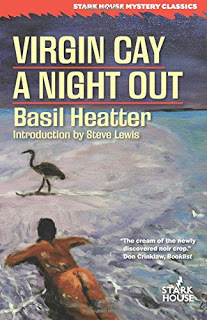
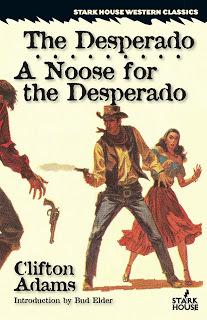 So it is, I revel in the chinks Stark House Press reveals in my reading armor by regularly publishing new collections of these forgotten gems under their Crime Classics banner. Not only are these collections packaged and priced attractively, the introductions by prominent names in the genre are often as valuable as the original prose that follows.
So it is, I revel in the chinks Stark House Press reveals in my reading armor by regularly publishing new collections of these forgotten gems under their Crime Classics banner. Not only are these collections packaged and priced attractively, the introductions by prominent names in the genre are often as valuable as the original prose that follows. This year alone, Stark House has brought me up to speed on Basil Heatter , Peter Rabe , Clifton Adams , and Carter Brown —three authors with whom I was familiar, but had never read, and another I was only aware of as a writer of Westerns. They also published the outstanding collection of introductions and essays by Rick Ollerman ( Hardboiled, Noir and Gold Medals ), which I wrote about in an earlier column.
In December, Stark House will release a collection of two novels, Perfect Victim/Winner Take All , by James McKimmey, introduced throug an interviewof McKimmey conducted by Allen Guthrie. This will be the second collection of McKimmey novels from Stark House, the first being Cornered!/The Long Ride , with an introduction by Bill Crider.
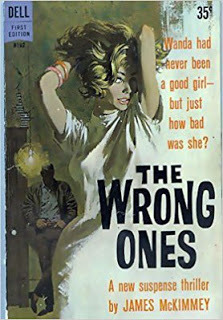
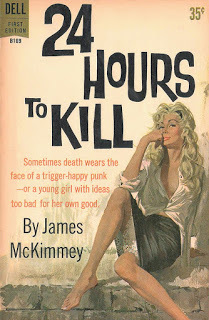
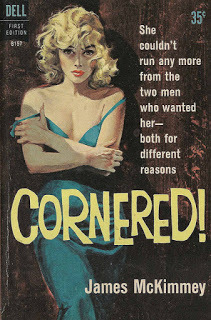
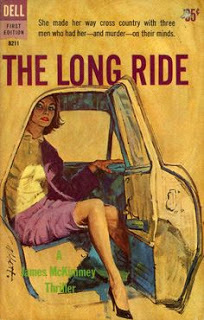
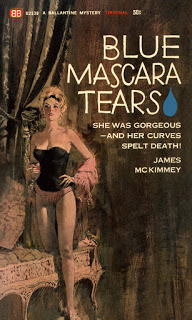
McKimmey was an author who had never registered on my radar before, but after reading Perfect Victim/Winner Take All, I immediately purchased Stark House’s first collection of McKimmey stories. I wanted more McKimmey, and I wanted it right away.
Checking the Internet for images of McKimmey's novels, I immediately recognized the amazing Robert McGinnis covers on the first edition paperbacks published by Dell Books. I realized I’d seen them before. I even had a couple on my shelf, collected strictly for the McGinnis covers.
Because of my unfamiliarity with Mckimmey, I had never cracked them open to read—a situation quickly rectified.
Best known for his crime fiction, McKimmey began his writing career churning out science fiction, juvenile stories, Westerns, and tales of adventure for the pulps. Looking to move up the pay scale, McKimmey began writing for the slicks (Saturday Evening Post, Colliers, etc.) in the mid-50s. His first novel, Perfect Victim, sold to Dell in 1957.
 McKimmey’s story structure is to present seemingly unrelated characters and eventually connecting them as needed to bring the plot to a boil. He establishes his main characters (and even his secondary characters to some extent) and our belief in them through the technique of dynamic dialogue, with his style relying minimally on descriptive passages. This keeps the story moving fast enough to keep the reader from thinking too hard about the coincidences and, at times, artificial set-ups, which often drive these types of stories.
McKimmey’s story structure is to present seemingly unrelated characters and eventually connecting them as needed to bring the plot to a boil. He establishes his main characters (and even his secondary characters to some extent) and our belief in them through the technique of dynamic dialogue, with his style relying minimally on descriptive passages. This keeps the story moving fast enough to keep the reader from thinking too hard about the coincidences and, at times, artificial set-ups, which often drive these types of stories.Reading like Jim Thompson filtered through the lens of James M. Cain, David Goodis, and John D. MacDonald, McKimmey deserves to be rediscovered and have a much higher profile with fans of compulsively readable tight, nasty, and twisted noirs. Kudos again to Stark House Press for keeping the flame burning.
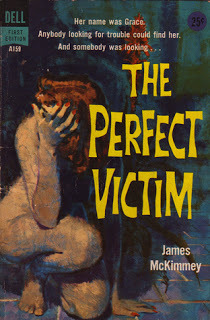 THE PERFECT VICTIM
THE PERFECT VICTIM Al Jackson, traveling salesman, knows that he isn’t likely to get any equipment sales in Willow Creek, but he’s nursing a hangover and stops here anyway. He’s a friendly guy, on the road too long, and can’t help flirting with the waitress, Grace. But Willow Creek folks don t take well to outsiders making time with their Grace. So when she is found murdered the next morning, everyone naturally assumes that the foreigner must have had something to do with it. And now Jackson is in jail while the town howls for blood. Only the real murderer knows what happened and he has no intention of letting the salesman live to see a courtroom.
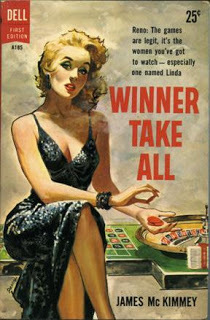 WINNER TAKE ALL
WINNER TAKE ALL You've kicked around the world, a soldier of fortune. But nothing prepares you for a man who shows up in your San Francisco hotel claiming to be your twin, with an offer to switch places for ten thousand dollars. Yeah, there's going to be some rough stuff you've got to settle your twin's gambling debt with some very dubious characters in Reno but the money looks good, and you're up for it. You get to live the high life for a while, which is something you could definitely get used to. But you don't figure on lovely Linda. And you sure don't figure on the neat double-cross that saps you right between the ears. Because, my friend, you've been swapped for murder!
Published on September 20, 2017 09:14
THE WOMEN OF MEN’S ADVENTURE
 THE WOMEN OF MEN’S ADVENTURE The paperback original men’s adventure and western series of the seventies and eighties provided a fertile proving ground for dozens of authors—some of whom wrote hundreds of books in the near uncountable number of series which proliferated during the time period. The huge majority of the writers of these action oriented, violence dripping, sex soaked series filled with lone wolf vigilantes, elite military teams, shoot first cops, lusty international spies, billionaire adventurers, and the many other variations had one thing in common—they were males. While they weren’t necessarily as hairy-chested, muscular, or quick-triggered as their fictional creations, they were certainly toiling in the traditionally male written, testosterone filled, genre.
THE WOMEN OF MEN’S ADVENTURE The paperback original men’s adventure and western series of the seventies and eighties provided a fertile proving ground for dozens of authors—some of whom wrote hundreds of books in the near uncountable number of series which proliferated during the time period. The huge majority of the writers of these action oriented, violence dripping, sex soaked series filled with lone wolf vigilantes, elite military teams, shoot first cops, lusty international spies, billionaire adventurers, and the many other variations had one thing in common—they were males. While they weren’t necessarily as hairy-chested, muscular, or quick-triggered as their fictional creations, they were certainly toiling in the traditionally male written, testosterone filled, genre.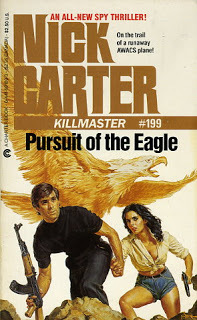 While the low rent end of Hemmingway Street was customarily male, there were a surprising number of women writers who embraced the macho guidelines of the genre—matching their male counterparts bullet for bullet, violence for violence, and sexual kink for sexual fetish. They infiltrated the genre seamlessly, proven by the fact no men’s adventure series reader ever stopped reading the latest installment, outraged because, “Hey! This was written by a broad!”
While the low rent end of Hemmingway Street was customarily male, there were a surprising number of women writers who embraced the macho guidelines of the genre—matching their male counterparts bullet for bullet, violence for violence, and sexual kink for sexual fetish. They infiltrated the genre seamlessly, proven by the fact no men’s adventure series reader ever stopped reading the latest installment, outraged because, “Hey! This was written by a broad!”Fortunately, a number of women writers who braved the world of men’s action adventure paperback series were willing to share their experiences…
GAYLE LYNDSGayle Lynds, now the acknowledged Queen Of Modern Espionage Fiction, began her literary spy career writing adventures for the Nick Carter: Killmaster series. The author of 10 bestselling international spy novels—including The Assassins, The Book of Spies, and The Last Spymaster—speaks freely about her early experiences in the men’s adventure genre...

In the early 1980s, I was divorced and struggling to find a way to support my two children. I was writing literary short stories, which I loved, but I was paid in copies of the journals in which they were published. Since paper was not a food group, and my children had grown accustomed to eating, and since the magazine I was editing wasn’t paying enough to support us, I turned to writing male pulp novels.
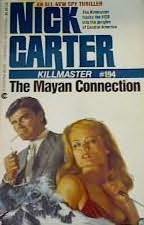 This serendipity was due to my husband-to-be, Dennis Lynds, aka Michael Collins, who signed the contracts and created the outlines for two Nick Carter novels, which I then wrote. The Nick Carter series has been around for decades, written by many male authors, and is sometimes described as an American version of James Bond. After I’d finished the first two, I insisted I take over creating the outlines for the next books in the contract. This was because I wanted to learn how to think the bones of a book.
This serendipity was due to my husband-to-be, Dennis Lynds, aka Michael Collins, who signed the contracts and created the outlines for two Nick Carter novels, which I then wrote. The Nick Carter series has been around for decades, written by many male authors, and is sometimes described as an American version of James Bond. After I’d finished the first two, I insisted I take over creating the outlines for the next books in the contract. This was because I wanted to learn how to think the bones of a book.In the end, I wrote five Nick Carters, all of which had international settings and were based on international political intrigue. I know that sometimes people are shocked I would “lower” myself to write pulp fiction, but I looked upon it as an exciting opportunity to grow and experiment as a writer. And, too, Dean Koontz and Martin Cruz Smith and Ross Macdonald and my husband and other fine authors had plowed those literary fields early in their careers. Why shouldn’t I?
Did the publisher ever know I was doing it? I doubt it. The contracts were in Den’s name because he was a known quantity, which meant we got the highest pay grade — a shockingly low $3,000 per book. Wahoo! But money was money, and I gloried in being allowed to experiment with character, scenes, and voice. I was even able to do multiple viewpoints. I looked upon it as a graduate course in popular writing...
TO VISIT GAYLE LYNDS’ WEBSITE CLICK HERE
MOLLY COCHRANMolly Cochran is the author of 27 published novels and four nonfiction books under her own name and various pseudonyms—including the teen paranormal romances Legacy, Poison, and Seduction. With co-author Warren Murphy, she also wrote the New York Times bestselling novels Grandmaster and The Forever King. She has lectured extensively and has taught writing at the college level as well as at a women's prison—insisting she was not an inmate at the time. In her dark and mysterious past, she also contributed a clutch of novels to one of the most iconic men’s adventure paperback series, The Destroyer. Molly remembers her time ghosting The Destroyerfondly...
 I think most Destroyer fans know I was one of several ghost writers who worked on the series. The fact I’m a woman hasn’t seemed to make much difference in the public’s response to my work, which has been pretty positive. Where it did make a difference was in my own grasp of the craft.
I think most Destroyer fans know I was one of several ghost writers who worked on the series. The fact I’m a woman hasn’t seemed to make much difference in the public’s response to my work, which has been pretty positive. Where it did make a difference was in my own grasp of the craft. Writing men’s action/adventure stretched me far beyond anything I might have reached for on my own. The Destroyer is not a vehicle for dreamy setups or vague descriptions, faults shared by many (bad) women’s novels. It is fast, action-packed, and plot driven. Ghosting this iconic series gave me discipline, confidence, and the ability to work under pressure.
As a writer, I have nothing but the deepest gratitude to Warren Murphy and Dick Sapir (who was still alive when I began ghosting for them). The twelve Destroyers I wrote provided the best postgraduate course in fiction writing I can imagine. Here are some of the things I learned directly from Warren, who was my main mentor:
 —People aren’t going to pay as much attention to every word as you do. When writing action, tell them you’re going to do it, do it, then tell them you did it.
—People aren’t going to pay as much attention to every word as you do. When writing action, tell them you’re going to do it, do it, then tell them you did it. —Nothing in a novel is inconsequential.
—Reaction propels the story forward as much as action.
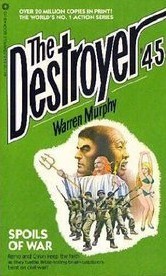 —Make sure every character’s motives are (or become) clear. People can be ambiguous, but fictional characters cannot.
—Make sure every character’s motives are (or become) clear. People can be ambiguous, but fictional characters cannot.—Writers don’t lose their talent. What they lose is their nerve. Don’t lose it. Always be willing to fall on your face.
After I completed my dozen Destroyers, Warren and I co-wrote Grandmaster, which won an Edgar Award, rose to #3 on the New York Times Bestseller List, and became an international bestseller. All in all, we wrote seven successful books together. Oh, and incidentally, we got married...Good times...
TO VISIT MOLLY COCHRAN’S WEBSITE CLICK HERE
ALICE DUNCANAuthor of romance westerns and the popular Daisy Gumm Majesty series set in the Roaring Twenties, Alice Duncan also made her bones in the world of men’s adventure fiction. Having written two books in the Trailsman adult western series (under the house name Jon Sharpe), Alice has her own slant on the quirks and challenges of the genre...
It was early in what I laughingly call my writing career, and I was incredibly single-minded and ambitious (a tendency I’ve since gotten over). I wanted to write everything. I’d written western romances and thought maybe I could write straight westerns without the romantic element.
 My agent approached an editor at Signet (can’t remember his name, but I do remember he was Canadian and his family had Beaucerons—a breed of guard and herding dog—working on their ranch). My agent had sent the editor a proposal for a western I was working on.
My agent approached an editor at Signet (can’t remember his name, but I do remember he was Canadian and his family had Beaucerons—a breed of guard and herding dog—working on their ranch). My agent had sent the editor a proposal for a western I was working on.The editor said he admired my writing, and would I like to write for the Trailsman series? I said sure, and went out and bought two of the novels. I knew the books contained a lot of sex, because my agent had warned me. I’d had an idea of having three pseudo-nuns running into Trailsman hero, Skye Fargo (and people say romance heroes have weird names). However, the first Trailsman book I read had three nuns in it. So, I scrapped that idea and decided to write a book set in the Pecos Valley in New Mexico Territory.
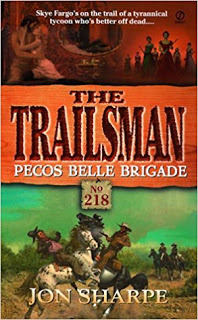
My new plot involved an evil rancher who has taken over a town. Skye Fargo intervenes and organizes a bunch of hookers to free the town from the rancher’s grip. As soon as the editor read the book (fortunately, those things were short), he said I had to rewrite it, as I’d clearly totally missed the concept of Skye Fargo being at every woman’s mercy. Even 18-year-old virgins seduced him (didn’t take much effort on their part). So, I made the required changes.
The second book was set in Gold-Rush California and involved a fake woman preacher who was really an evil gambler. Skye Fargo manages to fool her, ruin her career as a fake evangelist, and save the town from further depravity—at least from her. They still had plenty of depravity going on from other sources. The editor said he still liked my writing, but he needed folks to write Trailsman books whose work didn’t need so much correction from him. I understood completely.
The main problem I had with the Trailsman-like westerns was writing too much introspection and too little action. I also absolutely and totally did NOT comprehend the male-fantasy aspect of the books, which had every woman alive wanting to jump Skye Fargo’s bones. Never mind he had a huge beard and wore buckskins that probably never got laundered (how do you launder buckskins anyway?), and he never had to make a move on a woman. All I could think of when I was writing those two books was how stinky Skye Fargo must be, you know? Not to mention how many people Skye had to kill in order to fulfill his purpose on earth.
Anyway, that ended my Trailsman career. A shame, too, because those books made me more money than any other books I’ve ever written. Sigh...
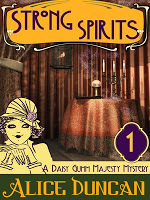 Along with writing her own Jazz Age cozies, Alice also edits the westerns for Five Star written by Peter Mean Pete Brandvold—who also cut his teeth writing Trailsmannovels. About Peter, Alice says, He’s a great writer, and he’s got the western thing down pat. In fact, I always lose track of the body count when I edit his books. Mean Pete KNOWS what a western is supposed to be. Wish I did. Oh, well...
Along with writing her own Jazz Age cozies, Alice also edits the westerns for Five Star written by Peter Mean Pete Brandvold—who also cut his teeth writing Trailsmannovels. About Peter, Alice says, He’s a great writer, and he’s got the western thing down pat. In fact, I always lose track of the body count when I edit his books. Mean Pete KNOWS what a western is supposed to be. Wish I did. Oh, well...TO VISIT ALICE DUNCAN’S WEBSITE CLICK HERE
MARILYN GRANBECKWriting as Marilyn Granbeck, Marilyn Ruth Henderson created and wrote all novels in two men’s adventure series—The Peacemaker and Blood. She also wrote one entry in the Nick Carter Killmaster series. Now a respected mystery writer, Granbeck believes her time writing men’s adventure novels set her up for success...

I began with short stories under the mistaken impression that short meant easier. I sold my first one eleven months after I had set my goal. During this time though, a remarkable thing had happened. One of the selling members of the writers' group offered to help me. He wrote and sold action/adventure and mystery/suspense paperback originals to a small Midwestern publisher I never knew existed. He gave me some of his books to read to see if I thought I could write the kind the publisher wanted.
That was my first real recognition that writing a book that sells meant writing for the intended market, not for myself. I had to come up with an idea and write a book the editor knew his readers would buy. Learning that important basic of marketing put me on the road to success. When I asked my mentor how I could ever repay him, he said—Pass it on some day…
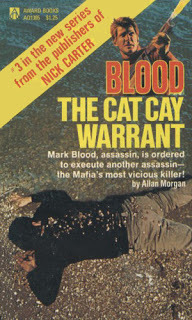 On his Glorious Trashblog, Joe Kenney gave an interesting perspective on Granbeck’s men’s adventure work in her Blood series...Granbeck usually fades to black in the sex scenes, though sometimes she gives a bit of the juicy details. It’s not full-on explicit but it’s more than nothing, and she has no qualms with describing the female anatomy. She even goes the extra mile by occasionally referring to breasts as tits. So clearly, she was making the attempt to cater to the demands of the genre. And yet for all of that, you can still detect something afoot, as Blood appears to develop feelings for most every girl, and indeed tells us he can’t have sex if there are no feelings involved – what more proof do you need that the writer was a woman?
On his Glorious Trashblog, Joe Kenney gave an interesting perspective on Granbeck’s men’s adventure work in her Blood series...Granbeck usually fades to black in the sex scenes, though sometimes she gives a bit of the juicy details. It’s not full-on explicit but it’s more than nothing, and she has no qualms with describing the female anatomy. She even goes the extra mile by occasionally referring to breasts as tits. So clearly, she was making the attempt to cater to the demands of the genre. And yet for all of that, you can still detect something afoot, as Blood appears to develop feelings for most every girl, and indeed tells us he can’t have sex if there are no feelings involved – what more proof do you need that the writer was a woman?JOANNE WALPOLEJoanne (Jo) Walpole is an establish writer of Black Horse Westerns under the pseudonym Terry James (a name apparently stolen from her husband). A Piccadilly Cowboy for a new generation, Jo’s new violent Western series Maggie O’Bannen is about to make a cannonball splash into the waters of men’s adventure series under the pseudonym Joe Slade. On her blog, Jo talks about her new series...
 Not long ago, I approached Piccadilly Publishing with an idea for a series. I wanted the freedom to 'go large', as I put it, and break away from the mainstream type westerns I had previously written. They were happy to let me run with it and off I went.
Not long ago, I approached Piccadilly Publishing with an idea for a series. I wanted the freedom to 'go large', as I put it, and break away from the mainstream type westerns I had previously written. They were happy to let me run with it and off I went.Recently, I submitted the first book in the Maggie O’Bannen series—Days Of Evil. It only took me 2 months to write from start to finish, which was a record for me and proves how much I enjoyed doing it. I'd go so far as to say it's my favourite book out of the seven I have had published since 2005. Piccadilly seem to agree.
I decided to use a different pseudonym for this one as it's more violent than anything I've written before and I wanted to draw a line of distinction between Terry James [the pseudonym she uses for her more traditional Black Horse Westerns) and this new version of me.
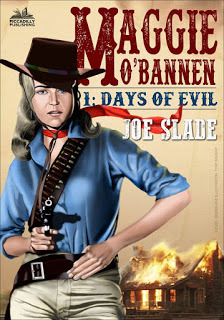 I'm very lucky to have had Tony Masero design the cover. I admit I was a little nervous as the women I'd seen on some of the Piccadilly covers tended towards overtly sexy and Maggie isn't that. I provided an overview of how I saw her and I think Tony Masero has done a really good job with her. I very much like the simplicity of the cover art overall.
I'm very lucky to have had Tony Masero design the cover. I admit I was a little nervous as the women I'd seen on some of the Piccadilly covers tended towards overtly sexy and Maggie isn't that. I provided an overview of how I saw her and I think Tony Masero has done a really good job with her. I very much like the simplicity of the cover art overall.The second book in the series is already under way with the working title, Wanted: Dead. I'm still very excited about Maggie and her band of misfits and am very much hoping readers will take to them as much as I have...
Maggie O’Bannen #1: Days Of Evil will be available November 6, 2017.
TO VISIT JO WALPOLE’S WEBSITE CLICK HERE
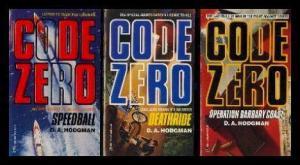 DOROTHY AYOOBIn the mid-'90's there were two men’s adventure series, Stakeout Squad and Code Zero, written by D. A. Hodgman. Both series were highly regarded series due to their high degree of verisimilitude regarding police procedure and the technical detail relating to firearms and ammunition.
DOROTHY AYOOBIn the mid-'90's there were two men’s adventure series, Stakeout Squad and Code Zero, written by D. A. Hodgman. Both series were highly regarded series due to their high degree of verisimilitude regarding police procedure and the technical detail relating to firearms and ammunition.
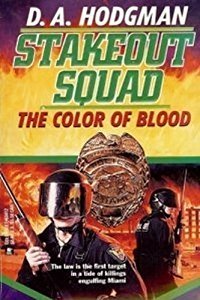 Reader Phil Wong felt the books read like a fictionalized version of the Ayoob Files, a regular column in the American Handgunnermagazine. In Wong’s opinion there was a strong chance D. A. Hodgman was a nom de plume for Massad Ayoob.
Reader Phil Wong felt the books read like a fictionalized version of the Ayoob Files, a regular column in the American Handgunnermagazine. In Wong’s opinion there was a strong chance D. A. Hodgman was a nom de plume for Massad Ayoob. Wong finally met Massad Ayoob in person. Hoping to get his copies of Stakeout Squad and Code Zero autographed, he asked Ayoob if he was indeed the man behind the D. A. Hodgman pseudonym. It turned out, however, D. A. stood for Dorothy Ayoob neé Hodgman, who had been Massad's wife. Massad served as the primary technical advisor on the books, but the actual writing was all done by Dorothy.
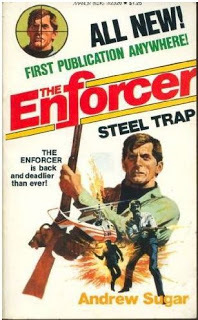 ANDREW / ANDREA SUGARThen there is the odd case of Andrew Sugar who wrote action and violence filled men’s adventure series such as the body-hopping-clone series The Enforcer, and the butt-kicking Israeli Commandos. Sugar famously sued Warner Bros. over their authorized novelization of The Enforcer—based on Clint Eastwood’s Dirty Harry film—claiming it had substantially injured him financially and caused damage to his property rights.
ANDREW / ANDREA SUGARThen there is the odd case of Andrew Sugar who wrote action and violence filled men’s adventure series such as the body-hopping-clone series The Enforcer, and the butt-kicking Israeli Commandos. Sugar famously sued Warner Bros. over their authorized novelization of The Enforcer—based on Clint Eastwood’s Dirty Harry film—claiming it had substantially injured him financially and caused damage to his property rights.
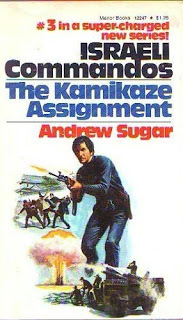 At the time of the court filing, however, Andrew Sugar had undergone a sex change operation and was now Andrea Sugar. An expert witness in the case stated Sugar wasn’t a bad looking woman, allowing for a missing lower front tooth.
At the time of the court filing, however, Andrew Sugar had undergone a sex change operation and was now Andrea Sugar. An expert witness in the case stated Sugar wasn’t a bad looking woman, allowing for a missing lower front tooth.Sugar was highly regarded as a men’s adventure novelist, which adds a certain irony to his journey as a woman starting out in a man’s body.
****** There are also numerous other examples of women writers exercising their literary muscles by contributing to men’s adventure paperback series.
J.B. KELLER
Keller wrote many entries in the Trailsman series. Her significant other was Trailsman series creator Jon Messmann—whose name is very well known in men’s adventure series circles as the creator of Jefferson Boone: The Handyman, The Revenger, and many more action series. However, when it comes to the Trailsman series, it’s unclear which of the two wrote which books—various books credited to Keller were written by Messmann and vice-versa.
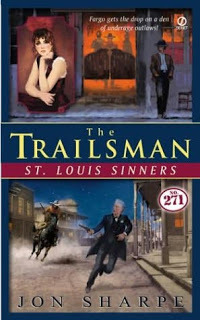 ELLEN RECKNOREllen Recknor wrote at least four entries in the Trailsman series as Jon Sharpe. She also wrote four Slocum books under the Jake Logan house name—three of which were Giant Editions. Unfortunately, there is no central listing to identifying the individual authors behind the Jake Logan pseudonym or which books they wrote. Unlike the listings for the Trailsman series on the U.S. Copyright site (where authors can be identified by painstakingly checking each entry), the great majority of the Slocumbooks do not have similar specific author information.
ELLEN RECKNOREllen Recknor wrote at least four entries in the Trailsman series as Jon Sharpe. She also wrote four Slocum books under the Jake Logan house name—three of which were Giant Editions. Unfortunately, there is no central listing to identifying the individual authors behind the Jake Logan pseudonym or which books they wrote. Unlike the listings for the Trailsman series on the U.S. Copyright site (where authors can be identified by painstakingly checking each entry), the great majority of the Slocumbooks do not have similar specific author information. Recknor had a lifelong interest in the Old West, which she found useful when she began her writing career. In 1998 she won a Spur Award from the Western Writers of America for Best Paperback Original, for Leaving Missouri. In 2000, she won the Best Novel of the West Spur Award for Prophet Annie. She passed away in 2014.
Recknor had a lifelong interest in the Old West, which she found useful when she began her writing career. In 1998 she won a Spur Award from the Western Writers of America for Best Paperback Original, for Leaving Missouri. In 2000, she won the Best Novel of the West Spur Award for Prophet Annie. She passed away in 2014. ARDATH MAYHARAs John Killdeer, Mayhar wrote the first six books in the Mountain Majesty series, in which frontiersman Cleve Bennett and his Cheyenne warrior wife fight for their high mountain freedom.Mayhar was nominated for the Mark Twain Award as well as numerous other nominations for awards in almost every fiction genre. She won many awards for her poetry. In 2008, she was honored by Science Fiction and Fantasy Writers of America as an Author Emeritus. Mayhar wrote over 60 books ranging from science fiction to horror to young adult to historical to westerns. Mayhar passed away in 2012.
ARDATH MAYHARAs John Killdeer, Mayhar wrote the first six books in the Mountain Majesty series, in which frontiersman Cleve Bennett and his Cheyenne warrior wife fight for their high mountain freedom.Mayhar was nominated for the Mark Twain Award as well as numerous other nominations for awards in almost every fiction genre. She won many awards for her poetry. In 2008, she was honored by Science Fiction and Fantasy Writers of America as an Author Emeritus. Mayhar wrote over 60 books ranging from science fiction to horror to young adult to historical to westerns. Mayhar passed away in 2012.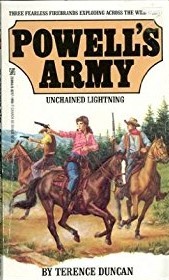 BARBARA PUECHNERAs Terence Duncan, Barbara Puechner wrote the first three books in the eight book Powell’s Armyseries. The title character of the series is Lt. Col. Amos Powell, who leads an army of fearless firebrands consisting of former soldier/Ranger Landrum Davis, the Dartmouth educated Gerald Glidinghawk, and Celia Burnett—who was adept at both shooting and riding.
BARBARA PUECHNERAs Terence Duncan, Barbara Puechner wrote the first three books in the eight book Powell’s Armyseries. The title character of the series is Lt. Col. Amos Powell, who leads an army of fearless firebrands consisting of former soldier/Ranger Landrum Davis, the Dartmouth educated Gerald Glidinghawk, and Celia Burnett—who was adept at both shooting and riding.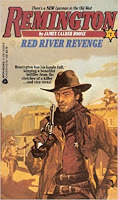 CHARLOTTE SHERMANWife of prolific Western writer Jory Sherman, Charlotte Sherman is credited to the seventh book in the Remington series under the house name, James Calder Boone. As Cort Martin she also wrote all the books in the Boltseries except the first—which was written by her husband.
CHARLOTTE SHERMANWife of prolific Western writer Jory Sherman, Charlotte Sherman is credited to the seventh book in the Remington series under the house name, James Calder Boone. As Cort Martin she also wrote all the books in the Boltseries except the first—which was written by her husband. OTHER WOMEN CONTRIBUTORSThe Hank Mitchum house name for the Stagecoach Station series was adopted by Kit Prate (three books), Michelle McQuaid (one book), and Amanda Cockrell Crowe(one book).
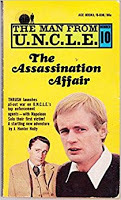 As John Holly, Joan Carol Holly got on the board writing one of the Ace original tie-in novels for The Man From U.N.C.L.E. series—The Assassination Affair.
As John Holly, Joan Carol Holly got on the board writing one of the Ace original tie-in novels for The Man From U.N.C.L.E. series—The Assassination Affair.Valerie Moolman was both editor and writer for numerous books in the Nick Carter Killmasterseries, while Linda Stewart and Dee Stuart each contributed two novels to the same series.
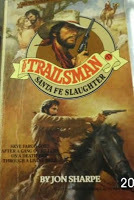 With her husband Ed, Martha Quillen contributed at least ten entries in the Trailsman series.
With her husband Ed, Martha Quillen contributed at least ten entries in the Trailsman series.Along with Jo Walpole (writing as Terry James), there are a number of Black Horse Westerns with female writers behind their pseudonyms.
******BELOW IS AN ADMITTEDLY INCOMPLETE LISTOF MEN'S ADVENTURE NOVELSATTRIBUTED TO WOMEN WRITERS...
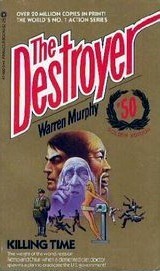 THE DESTROYER Molly Cochran:
THE DESTROYER Molly Cochran:Balance of Power / Spoils of War
Next of Kin / Dying Space
Skin Deep / Killing Time
Shock Value / Time Trial
Last Drop / Master's Challenge
Date with Death / The Eleventh Hour
NICK CARTER KILLMASTER Gayle Lynds:
The Mayan Connection/ Day of the Mahdi
Pursuit of the Eagle/ White Death
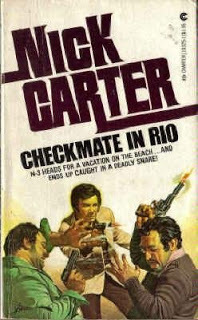
Valerie Moolman Run, Spy, Run (with Michael Avallone)
The China Doll (with Michael Avallone)
Saigon (with Michael Avallone)
The Mind Poisoners (with Lionel White)
Checkmate in Rio / Safari for Spies
Fraulein Spy / A Bullet for Fidel
The 13th Spy / The Terrible Ones
Hanoi / The Weapon of Night
Linda Stewart:
The Peking Dossier / The Jerusalem File
Marilyn Granbeck:
Assignment: Intercept
Dee Stuart: Death Message: Oil 74-2 / Pamplona Affair
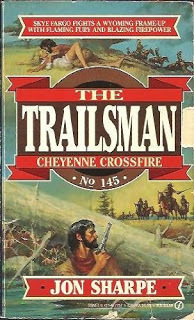 TRAILSMAN J. B. Keller:
TRAILSMAN J. B. Keller:Death Blow Trail / Cheyenne Crossfire
Coins of Death / Crowheart’s Revenge
Silver Maria / Silver River Conspiracy
Texas Triggers / Buffalo Guns
California Quarry / Ambush At Skull Pass
Ghost Ranch Massacre / Tornado Trail
Yukon Massacre / Colorado Carnage
Sutter’s Secret / Betrayal At El Dorado
Vengeance At Dead Man Rapids
Fort Range Conspiracy / Black Gulch Gamble
Salmon River Rage
Alice Duncan: Pecos Belle Brigade / California Crusader
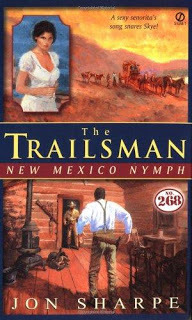 Ellen Recknor: St. Louis Sinners / New Mexico Nymph
Ellen Recknor: St. Louis Sinners / New Mexico Nymph Silver Mountain Slaughter / Kansas City Swindle
Martha Quillen (with Ed Quillen): Colorado Robber / Minnesota Missionary
Smoky Hell Trail / Utah Slaughter
Texas Hell Country / Cave of Death
Death’s Caravan / Desperate Dispatch
Mexican Massacre / Santa Fe Slaughter
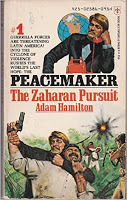 PEACEMAKER
PEACEMAKERMarilyn Granbeck:
The Zaharan Pursuit
The Yashar Pursuit
The Xander Pursuit
The Wyss Pursuit
BLOOD
Marilyn Granbeck:
Blood / The Spandau Warrant
The Cat Cay Warrant
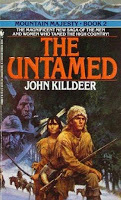 MOUNTAIN MAJESTYArdath Mayhar:The Untamed / Wild Country Wilderness Rendezvous
MOUNTAIN MAJESTYArdath Mayhar:The Untamed / Wild Country Wilderness RendezvousBlood Kin / Mountains West
The Far Horizon
POWELL’S ARMY
Barbara Puechner:
Unchained Lightning
Apache Raiders
Mustang Warriors
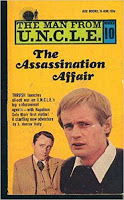 THE MAN FROM U.N.C.L.E.
THE MAN FROM U.N.C.L.E.Joan Carol Holly:
The Assassination Affair
REMINGTON Charlotte Sherman:
Red River Revenge
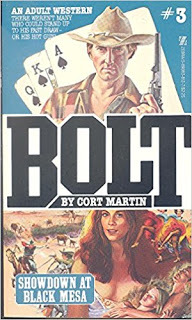 BOLTCharlotte Sherman:Dead Man's Bounty / Showdown At Black Mesa The Guns of Taos / Shootout At Santa Fe
BOLTCharlotte Sherman:Dead Man's Bounty / Showdown At Black Mesa The Guns of Taos / Shootout At Santa FeTombstone Honeypot / Rawhide Woman
Hard in the Saddle / Badman's Bordello
Bawdy House Showdown / The Last Bordello
The Hangtown Harlots / Montana Mistress
Virginia City Virgin / Bordello Backshooter
Hardcase Hussy / Lone Star Stud
Queen of Hearts / Palomino Stud
Six-Guns and Silk / Deadly Withdrawal
Climax Mountain / Hook Or Crook
Rawhide Jezebel / Not On the Warpath
Maverick Mistress
MAGGIE O’BANNEN
Jo Walpole:Days of Evil / Wanted: Dead
CODE ZERO
Dorothy Ayoob
Speedball
Deathride
Operation Barbary Coast
STAKEOUT SQUAD
Dorothy Ayoob
Line of Fire
Miami Heat
Color of Blood
Published on September 20, 2017 09:11
SOUTH AFRICAN PULP
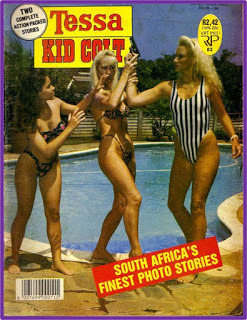
 SOUTH AFRICAN PULP
SOUTH AFRICAN PULPLast year, I wrote a post examining the phenomenon of Lance Spearman ( CLICK HERE ), the superhero spy (known as the black James Bond) of a long running series of South African fotoboekies or look books/photo books—a term coined for magazines featuring action photographs accompanied by comic strip style captions. These hybrid comics are relatively unknown in America. However in many other parts of the world, these comic mash-ups had a rabid following from the ‘60s to the late ‘80s. In Africa, fotoboekies served as surrogate movies—a way to tell film-like stories—at a time when commercial African cinema had not yet been invented.
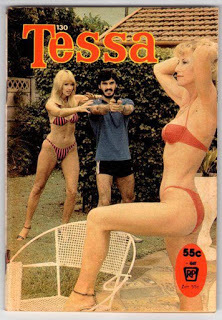 Recently, I came across an interesting short documentary on YouTube (
CLICK HERE
) celebrating South African fotoboekies kultuur—which translates as pulp photo story culture. I also came across a trove of covers for a photo-book series named after its gorgeous title character, Tessa, a platinum blonde who battled evil the jungles of urban South Africa clad only in a bikini and high heels. Clashing with sinister looking individuals wearing bad suit and sunglasses, Tessa always came out on top, with not a strand of her bottled blonde hair out of place.
Recently, I came across an interesting short documentary on YouTube (
CLICK HERE
) celebrating South African fotoboekies kultuur—which translates as pulp photo story culture. I also came across a trove of covers for a photo-book series named after its gorgeous title character, Tessa, a platinum blonde who battled evil the jungles of urban South Africa clad only in a bikini and high heels. Clashing with sinister looking individuals wearing bad suit and sunglasses, Tessa always came out on top, with not a strand of her bottled blonde hair out of place. 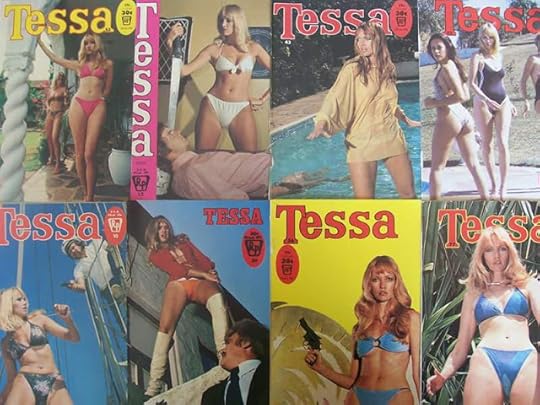 To her ardent continent-wide fans, Tessa, the bikini-clad, Karate kicking government agent, was akin to a goddess. Every 30,000 copy issue of Tessa sold out almost instantaneously on the newsstands—creating a lucrative secondhand market. Those 30,000 copies in today’s Internet savvy market would equal numbers to put the Kardashian’s Twitter followers to shame.
To her ardent continent-wide fans, Tessa, the bikini-clad, Karate kicking government agent, was akin to a goddess. Every 30,000 copy issue of Tessa sold out almost instantaneously on the newsstands—creating a lucrative secondhand market. Those 30,000 copies in today’s Internet savvy market would equal numbers to put the Kardashian’s Twitter followers to shame.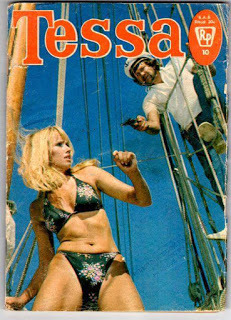 The South African publishing company Republican Press were the low-budget force behind the phenomenon of the photo comics Tessa and Kid Colt, as well as the Playboy knockoff Scope. At its zenith, Republican Press was printing 20 different fotoboekiesa month. Grafting Western influenced literary myths onto African settings, fotoboekies were most often written by authors based in Johannesburg—many of them black South African students working for minimal pay—then photographed by white professional shutterbugs using a team of black actors in Swaziland.
The South African publishing company Republican Press were the low-budget force behind the phenomenon of the photo comics Tessa and Kid Colt, as well as the Playboy knockoff Scope. At its zenith, Republican Press was printing 20 different fotoboekiesa month. Grafting Western influenced literary myths onto African settings, fotoboekies were most often written by authors based in Johannesburg—many of them black South African students working for minimal pay—then photographed by white professional shutterbugs using a team of black actors in Swaziland. 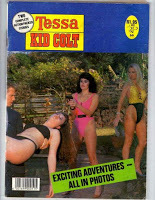
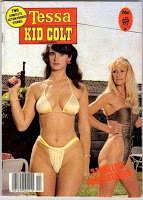
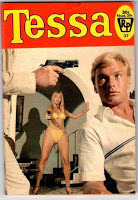 The actors were mostly locals from working-class neighborhoods. While the top fotoboekie models were paid 25 to 30 rand a day—which at the time was a lucrative way to pay your rent—most appearance fees were negligible. The recognizable main male actors were generally consider eccentric, hard-living, womanizers. Working quickly, an entire book could be shot in one to three days depending on the complexity of the simple sets.
The actors were mostly locals from working-class neighborhoods. While the top fotoboekie models were paid 25 to 30 rand a day—which at the time was a lucrative way to pay your rent—most appearance fees were negligible. The recognizable main male actors were generally consider eccentric, hard-living, womanizers. Working quickly, an entire book could be shot in one to three days depending on the complexity of the simple sets. 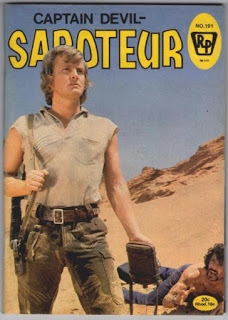
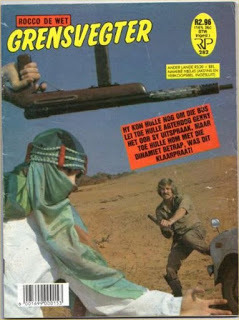

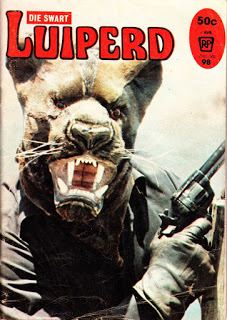 There were also army heroes—Swart Luiperd, Wit Tier, Kaptein Duiwel, Grensvegter (Black Leopard, White Tiger, Captain Devil, Grantsman) and others. They were most often depicted out in the jungle clutching their wooden machine guns, killing cigar smoking Cuban clones. Almost always, the villains held the proverbial disheveled damsel in distress captive after her convoy/aircraft/helicopter/hospital was invaded/crashed/broke down. The real South African soldiers who read these outrageous tales figured they could go back to civilian life if only these heroes existed outside their fervent imaginations.
There were also army heroes—Swart Luiperd, Wit Tier, Kaptein Duiwel, Grensvegter (Black Leopard, White Tiger, Captain Devil, Grantsman) and others. They were most often depicted out in the jungle clutching their wooden machine guns, killing cigar smoking Cuban clones. Almost always, the villains held the proverbial disheveled damsel in distress captive after her convoy/aircraft/helicopter/hospital was invaded/crashed/broke down. The real South African soldiers who read these outrageous tales figured they could go back to civilian life if only these heroes existed outside their fervent imaginations.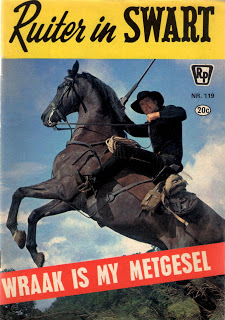 Fotoboekie cowboy heroes were also featured regularly. Danie van Rensburg was Ruiter in the Swart (Rider In Black), one of the first photo books published by Republican Press in 1966. Ruiter in the Swart became arguably the most popular of the cowboy fotoboekies.
Fotoboekie cowboy heroes were also featured regularly. Danie van Rensburg was Ruiter in the Swart (Rider In Black), one of the first photo books published by Republican Press in 1966. Ruiter in the Swart became arguably the most popular of the cowboy fotoboekies. The storyline focused on the character of Ben riding across the 1880s Lowveld—a low-lying subtropical climate where broad-leaved trees and thorn trees co-exist in relatively open woodland, interspersed with long grass and lots of game. After his son is kidnapped, Ben makes it his life's ambition to root out evil while searching for his son.
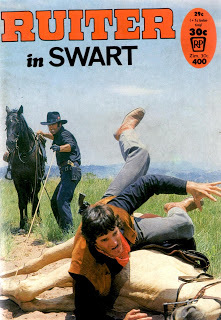 When the series ended after 17 years and 491 issues, Ben's son was still missing, but many evil-doers had been put down. In 2012, the character was still fondly remembered. Ruiter in Swart Productions produced a film version, which brought Danie van Rensburg to his most popular role 30 years after the last print version.
When the series ended after 17 years and 491 issues, Ben's son was still missing, but many evil-doers had been put down. In 2012, the character was still fondly remembered. Ruiter in Swart Productions produced a film version, which brought Danie van Rensburg to his most popular role 30 years after the last print version. 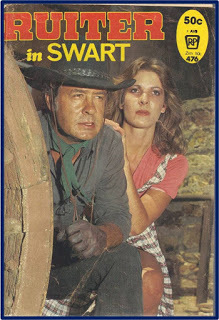 In the movie version, Ben is retired from the ZARP (Zuid Afrikaanse Republiek Polisie). When evidence his long lost son, Eben, is leading a gang of cattle rustler, Ruiter in Swart has no hesitation in donning his famous black outfit, strapping on his gun belt, saddling his black stallion, and setting out in pursuit.
In the movie version, Ben is retired from the ZARP (Zuid Afrikaanse Republiek Polisie). When evidence his long lost son, Eben, is leading a gang of cattle rustler, Ruiter in Swart has no hesitation in donning his famous black outfit, strapping on his gun belt, saddling his black stallion, and setting out in pursuit.In a real world twist, Ruiter in Swart’s manly star, Danie van Rensburg, was married to Erna van der Westhuisen, the sexy lady who played Tessa.
Etienne van der Westhuizen starred as Kid Die Swerwer (Kid Colt), a fotoboekie cowboy who would share pages with Tessa as the popularity of the photo book declined. Born in a province of South Africa known as Free State, Etienne van der Westhuizen was an outstanding college rugby player.
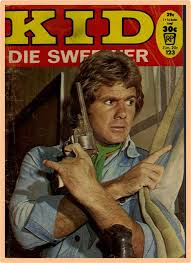 While sitting on the beach when the weather was to bad to go fishing, he was approached by a fotoboekie scout who asked if he was interested in playing a part in a Western photo story. Fortunately for Etienne, he could ride horses and do stunt work. After the first week, he was hired to work on a regular basis.
While sitting on the beach when the weather was to bad to go fishing, he was approached by a fotoboekie scout who asked if he was interested in playing a part in a Western photo story. Fortunately for Etienne, he could ride horses and do stunt work. After the first week, he was hired to work on a regular basis. 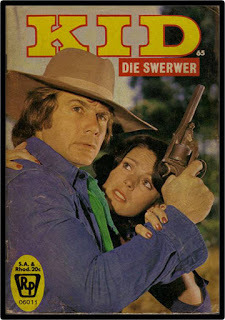 Many of the cowboy fotoboekies where shot at an old monastery, which was the perfect backdrop for a Western. Etienne was constantly riding horses for every issue only to have to fall off them again and again to be sure of capturing the right photo. Another Western set were the scrub bushes and sand dunes in an area around the Umgababa. The dunes were so steep the horses couldn’t be used. However, if a script called for desert sequences, Etienne and the other actors had to create their scenes on the difficult slopes. Etienne eventually became an organizer—taking charge of photo stories and organizing the wardrobe, changes of clothing, and continuity.
Many of the cowboy fotoboekies where shot at an old monastery, which was the perfect backdrop for a Western. Etienne was constantly riding horses for every issue only to have to fall off them again and again to be sure of capturing the right photo. Another Western set were the scrub bushes and sand dunes in an area around the Umgababa. The dunes were so steep the horses couldn’t be used. However, if a script called for desert sequences, Etienne and the other actors had to create their scenes on the difficult slopes. Etienne eventually became an organizer—taking charge of photo stories and organizing the wardrobe, changes of clothing, and continuity.Of his time starring as Kid Die Swerwer, Etienne is quoted as saying:
 Friends from yesteryear still call me Kid—but back then it was very much a name. At one stage, right at the beginning of the book, it was very hard to sit in a restaurant and not have kids point at you and have people ask whether you were that guy from the book. At the end of the day, I thought of myself more as a stunt rider than anything else, but I got to meet lovely people from all walks of life. Whenever we needed extras, we’d go down to the beach and chat to folks—usually backpackers from Australia or New Zealand—and offer them bit parts. It was great fun.
Friends from yesteryear still call me Kid—but back then it was very much a name. At one stage, right at the beginning of the book, it was very hard to sit in a restaurant and not have kids point at you and have people ask whether you were that guy from the book. At the end of the day, I thought of myself more as a stunt rider than anything else, but I got to meet lovely people from all walks of life. Whenever we needed extras, we’d go down to the beach and chat to folks—usually backpackers from Australia or New Zealand—and offer them bit parts. It was great fun.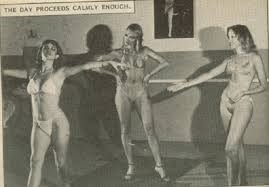 The Hang Fire Booksblog features a post (
CLICK HERE
) with an account from Dianne, a model who was often featured as a secondary character in the Tessa books...
The Hang Fire Booksblog features a post (
CLICK HERE
) with an account from Dianne, a model who was often featured as a secondary character in the Tessa books...Most of the filming was done at Republican Press in Mobeni, Durban. They had a separate section which was used for photo stories and they had various sets arranged—a jail, operating theatre, doctors office, etc.
 On the whole, it only took a morning to shoot the entire book. We used to get there by 0830 and were finished between 1200 and 1400 depending on your part in the book. We would bring three day outfits, one evening outfit, and a bikini. All of us became quite adept at changing in the back of the Combi [a slang word for the VW van used on sets as a trailer for the actors]. It was a good laugh to go through the books when they were published and see all the mistakes that were made!
On the whole, it only took a morning to shoot the entire book. We used to get there by 0830 and were finished between 1200 and 1400 depending on your part in the book. We would bring three day outfits, one evening outfit, and a bikini. All of us became quite adept at changing in the back of the Combi [a slang word for the VW van used on sets as a trailer for the actors]. It was a good laugh to go through the books when they were published and see all the mistakes that were made!

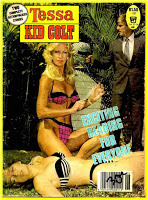 These mass produced popular culture pulps, along with many similar fotoboekies, were considered disposable at the time of their publication. Today, they have become lovingly remembered collectors items and even a literary history of their times.
These mass produced popular culture pulps, along with many similar fotoboekies, were considered disposable at the time of their publication. Today, they have become lovingly remembered collectors items and even a literary history of their times.
Published on September 20, 2017 09:07



